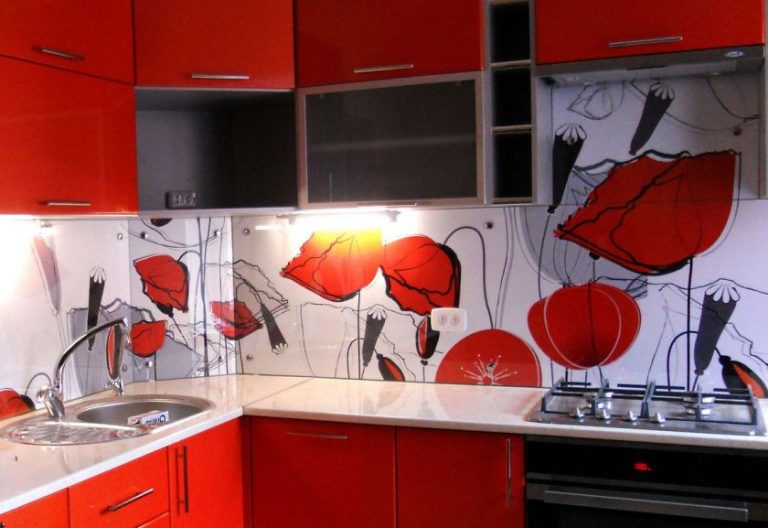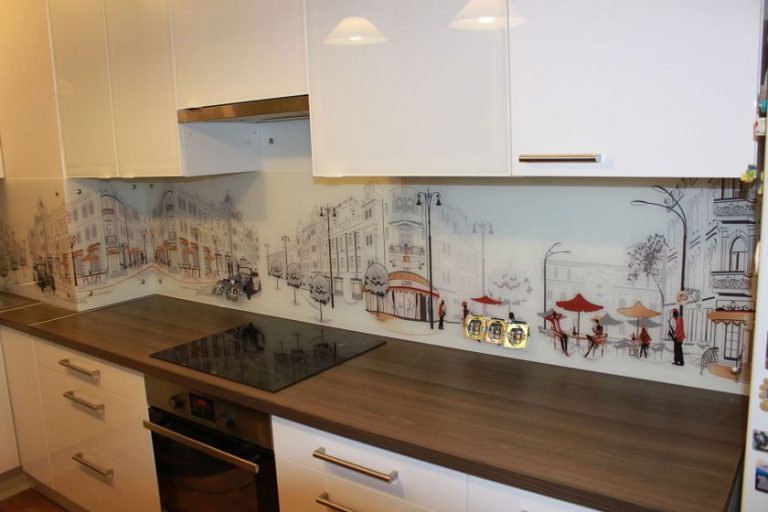Download glass aprons for the kitchen. Kitchen aprons with photo printing: photos of interesting and non-standard solutions
Original decor there will be photo printing in the kitchen, which will be an excellent protection for walls from grease and water, and beauty will attract the attention of guests.
Varieties of aprons with photo printing
kitchen aprons
Skinali made of tempered glass (frosted, tinted or transparent) came into fashion. Thickness can also vary larger area thicker glass required.
Now skinali are very popular - kitchen aprons with photo printing. In addition to accurate measurements, you will need to make sockets and fix roof rails, etc.
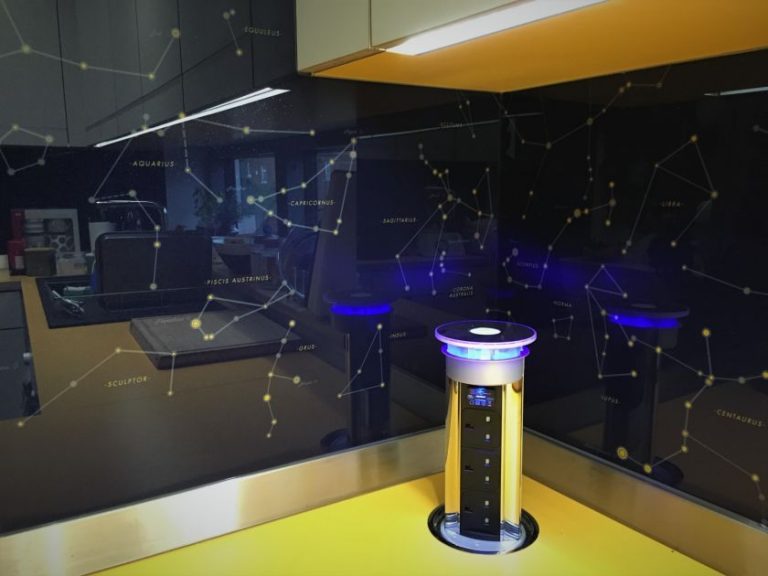
Advice! Sockets should be planned in advance, and not after installing the apron.
A complex installation is expensive, in addition to photo printing, you can decorate the apron with a sandblasted pattern. There is an image on the inside of the glass panel, so the front side cannot be harmed.
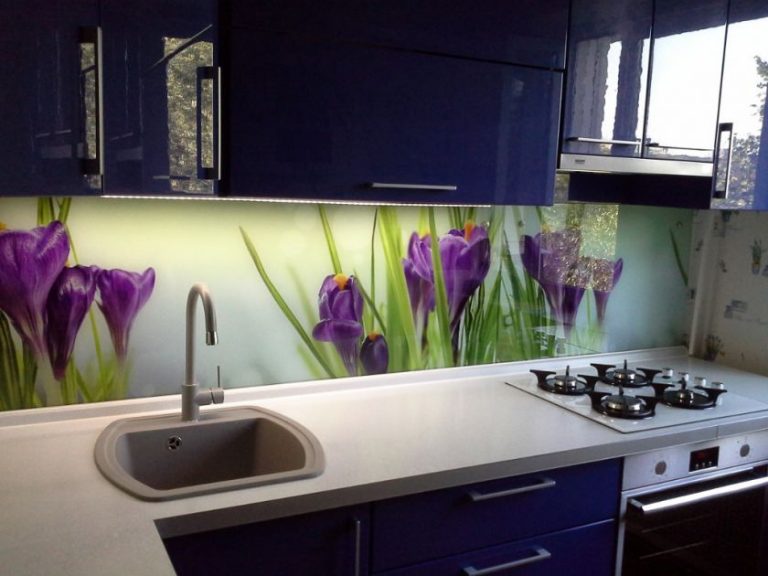
Advantages:
- Easy care with detergents (without abrasive particles), wet wipes.
- Great strength, falling pans (frying pans) will not spoil the surface.
- A huge selection of drawings (from catalogs or from custom order). You can send photos of your landscape, birds, animals, waterfalls, etc. They can be transferred to a picture for photo printing on an apron.
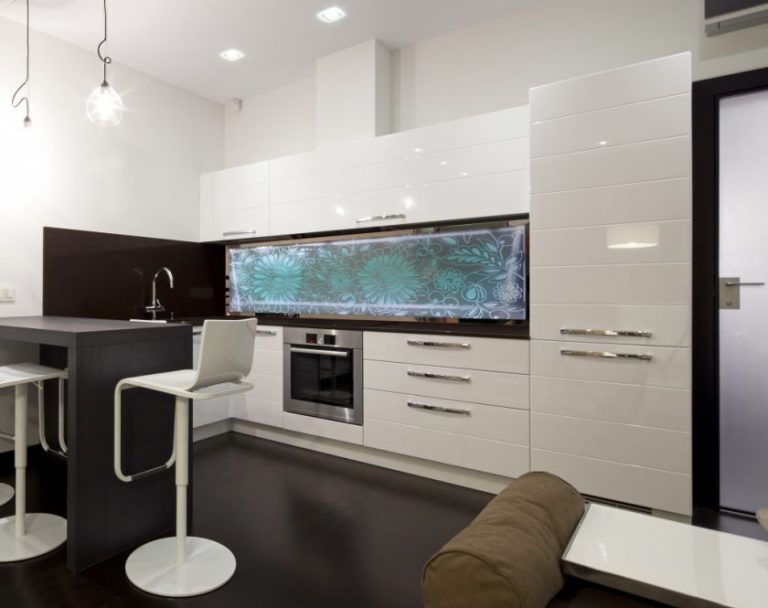
Flaws:
- The high price was thrown off, about 4700 rubles / 1 sq. m., made of glass more than 5000 rubles / 1 sq. m.
- Installation specifics require an accurate sketch, then assembly kitchen set, only after that the installation was skinned (apron).
plastic aprons
Plastic is nice and affordable option. It is often ordered together with a beautiful countertop, a single decor is most effective.
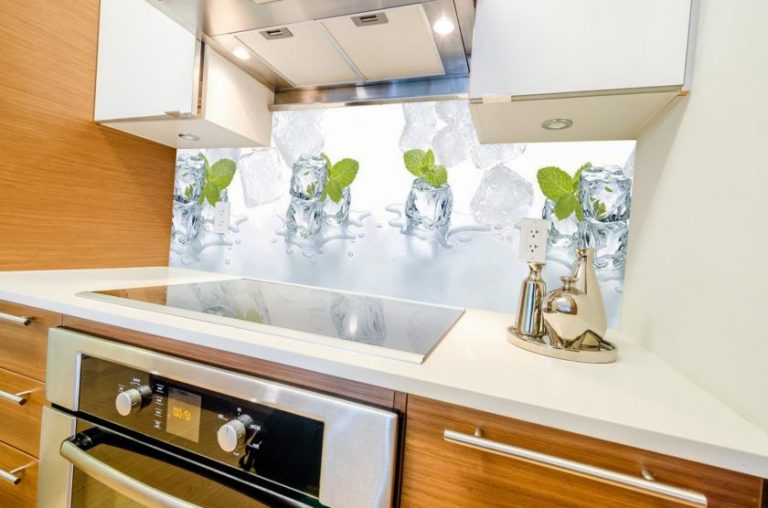
With photo printing will look advantageous. All you need to do is choose the right style and color. An apron based on a personal photo of the customer will be more expensive than from the catalog, but you will get what you wanted. Illumination will decorate and enliven the kitchen.

Advantages:
- Inexpensive price.
- Easy installation, easy even with your own hands. Cutting and processing plastic does not take much time,
- knowledge and labor.
- Moisture resistance.
- Resistant to high temperatures.
- Easy care by any means.
- Complete safety (there will be no fungi, mold, etc.).
- Always easy to replace without moving the furniture.

Flaws:
- The plastic is not very strong, it can be deformed at very high temperatures. Recommended for use with induction cooktops or electric ovens.
- Brittleness if abrasive products or hard brushes are used. This can be avoided by choosing a small pattern, then small scratches will not be noticeable.
- Not environmentally friendly, bacteria, various fungi and mold multiply easily.
Fastening methods
For the installation of panels for a kitchen apron, you can invite professional craftsmen. But more often they want to install skinali on their own.
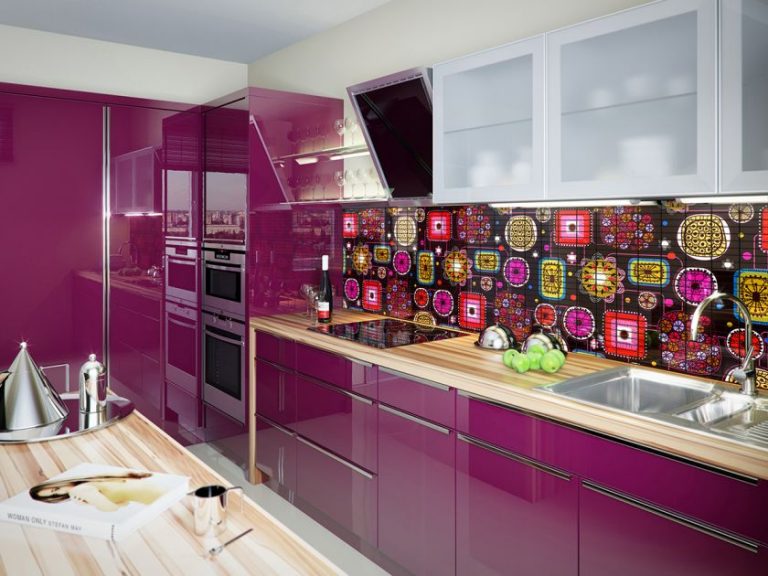
Let's analyze the types of different apron fasteners for the kitchen with photo printing:
Can be glued special composition opaque glass to the wall. Here important condition for a quality installation is a perfectly smooth and even surface.
The second option - you can fix metal profiles well on the walls in advance, and insert the finished kitchen apron into it.
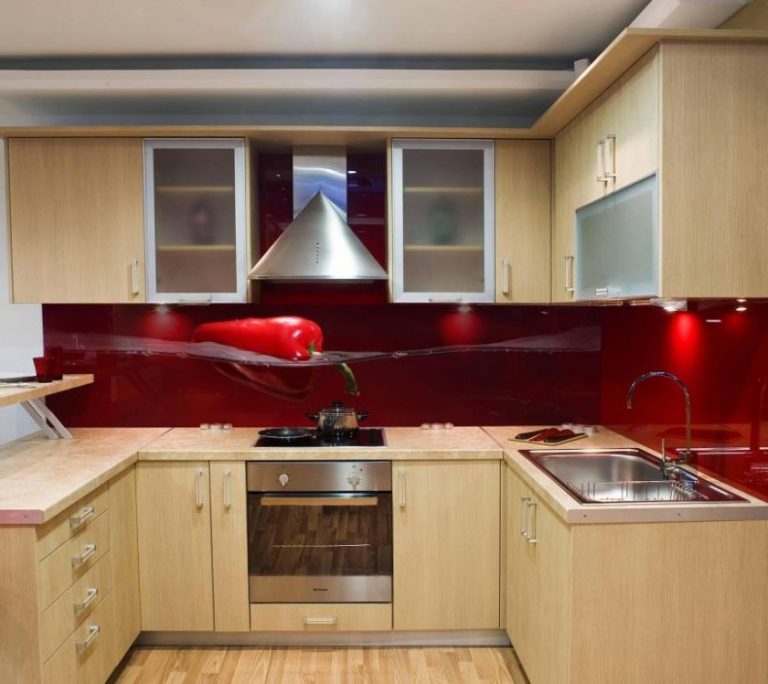
The most commonly used in the installation of fasteners. Holes must be made in the glass panel through which the panel will be attached to the wall.
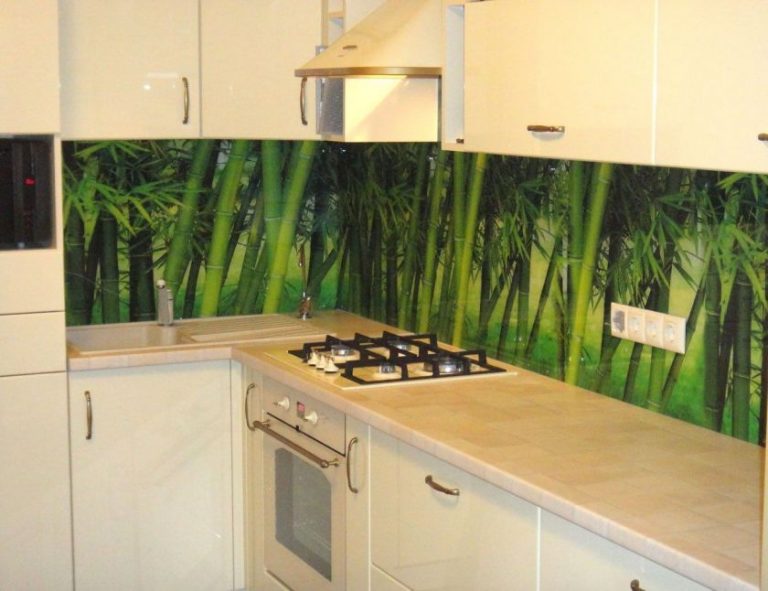
It's completely simple, the instructions for installing the skins are simple. First, the walls are well leveled, after which they need to be glued with liquid nails.


We figured out how to choose an apron with photo printing. If you follow the advice of professionals, everyone will cope with this task.
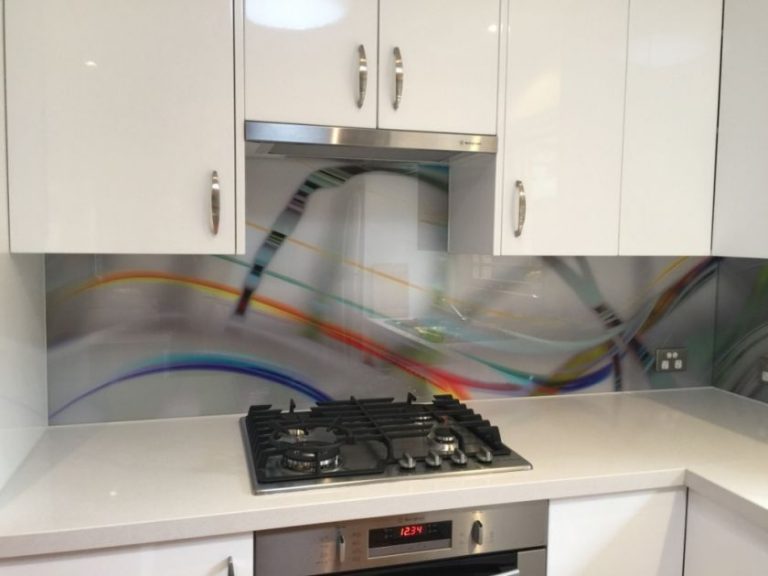
The most problematic kitchen area, where constantly hot steam, splashes of cold and hot water, fat and fumes, can be turned into decorative ornament. An unusual image on a photo print will make the kitchen an unusual corner with bright illumination, so that food is cooked better and tastier. This will always cheer you up, cleaning will be easier and faster.
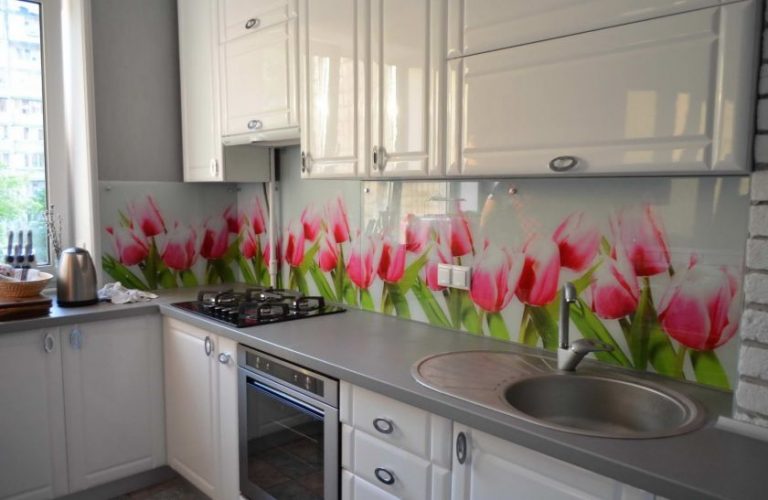
Knowing in advance all the advantages and disadvantages different materials, it is easy to select the desired option.
Photo of a kitchen apron with photo printing
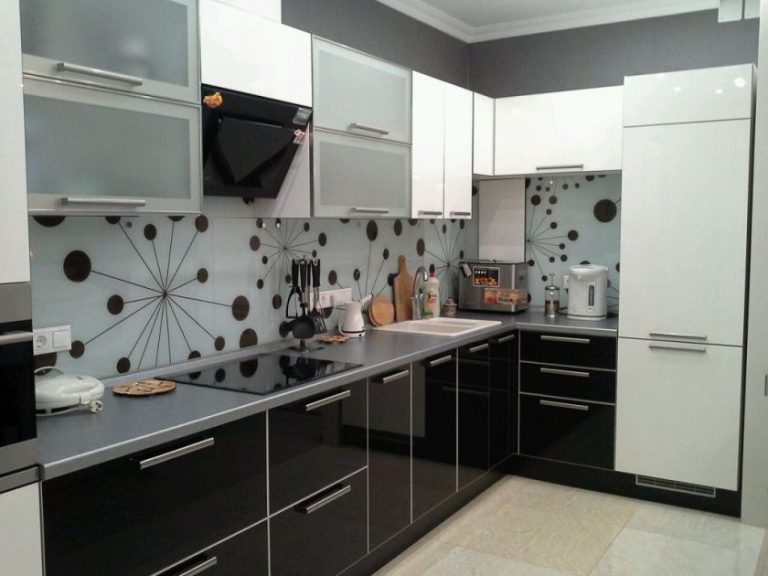
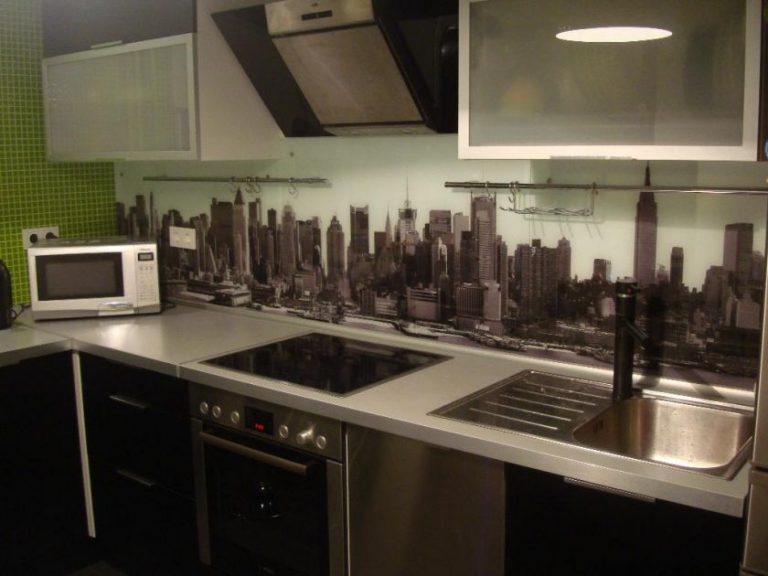


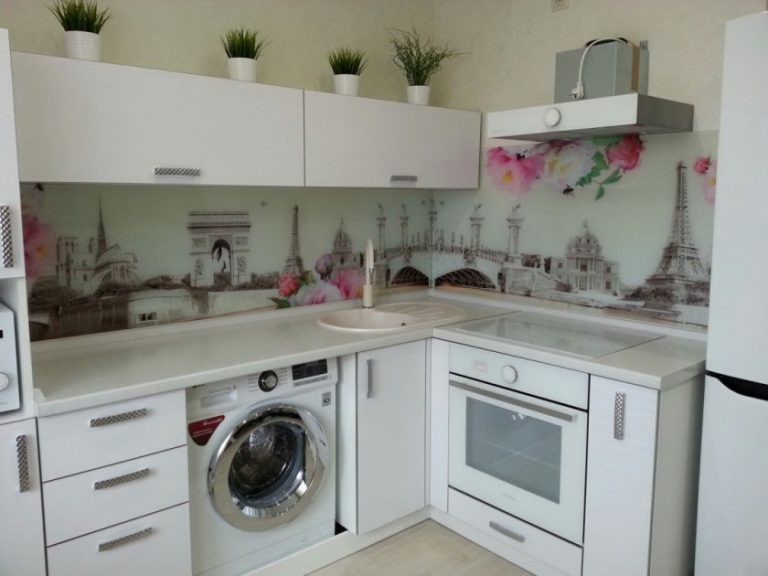
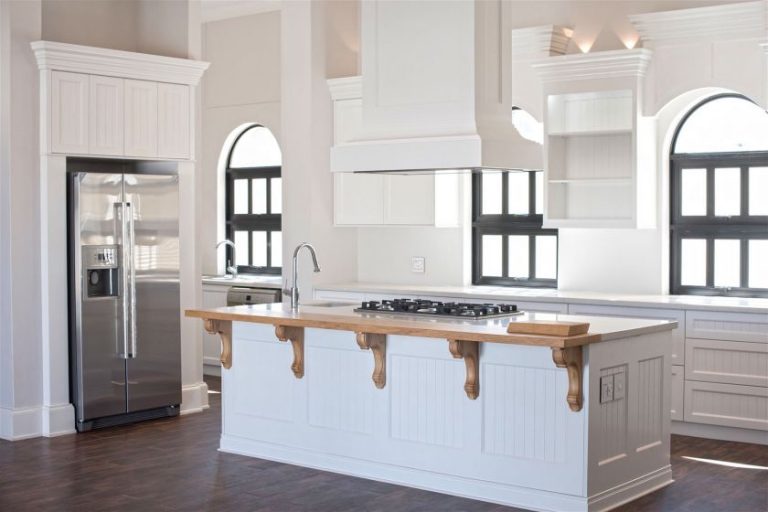
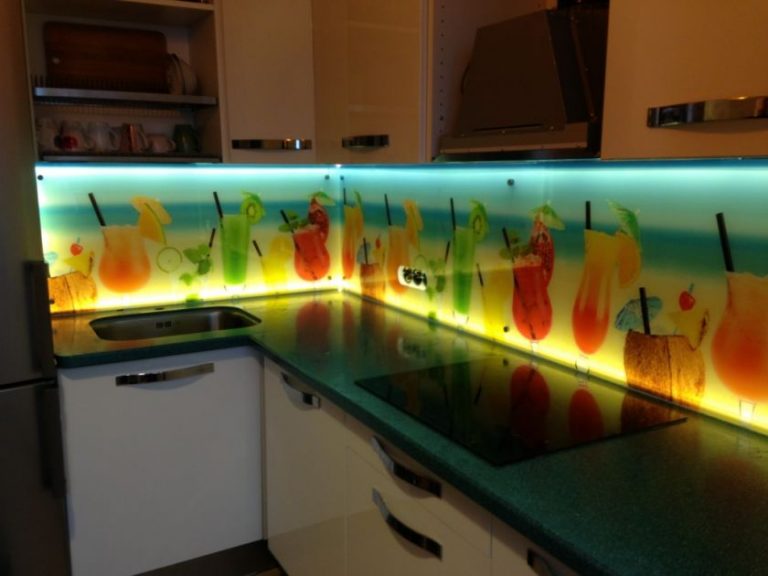
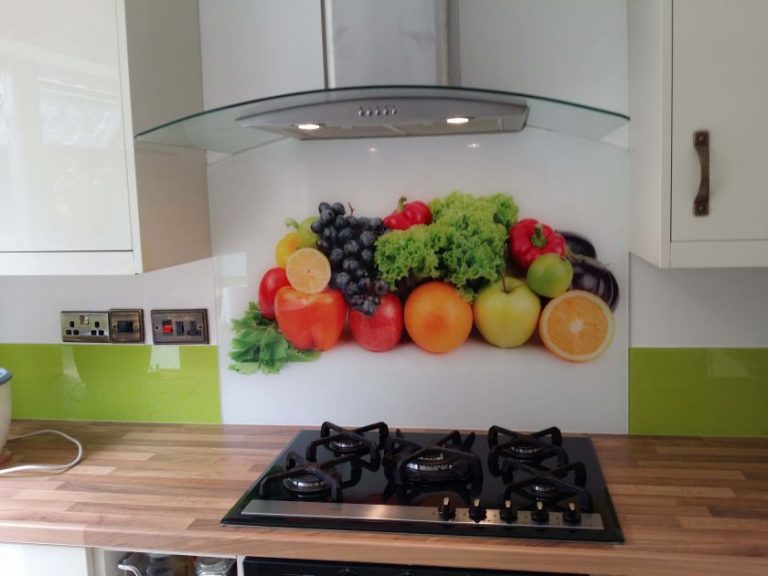
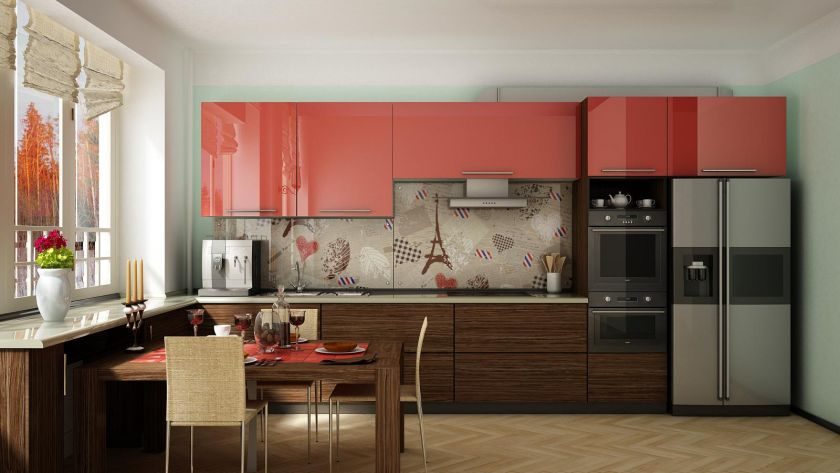
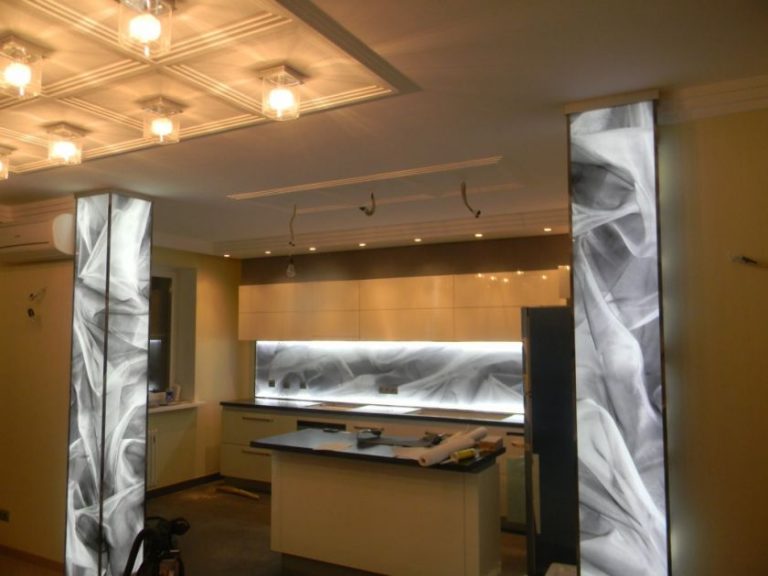
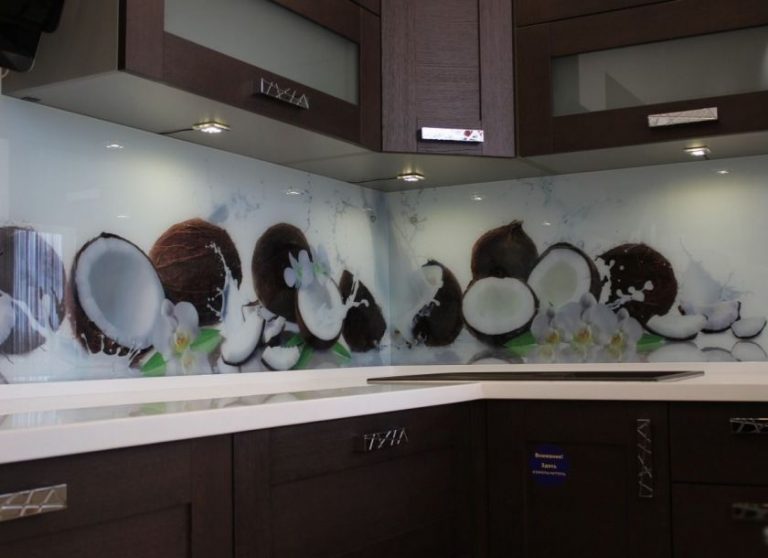


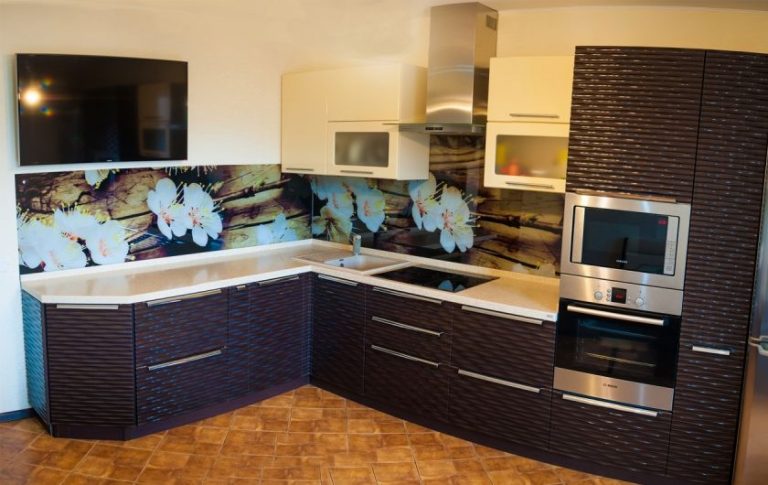

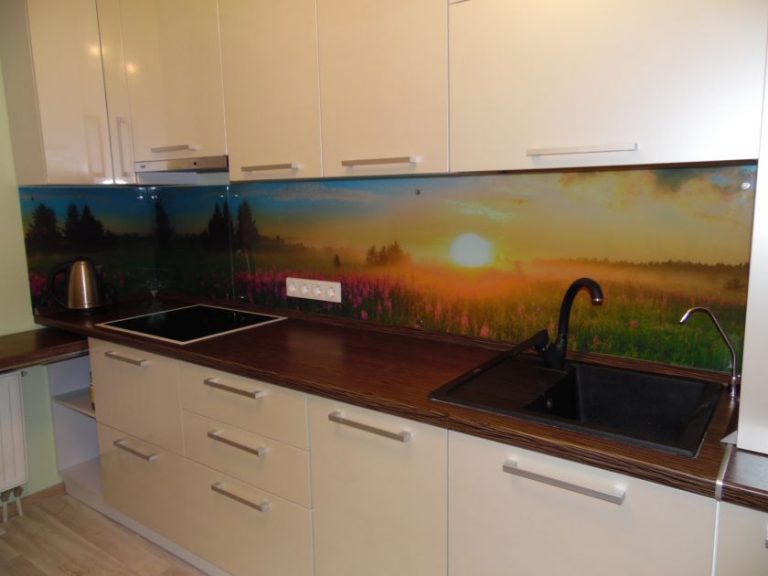
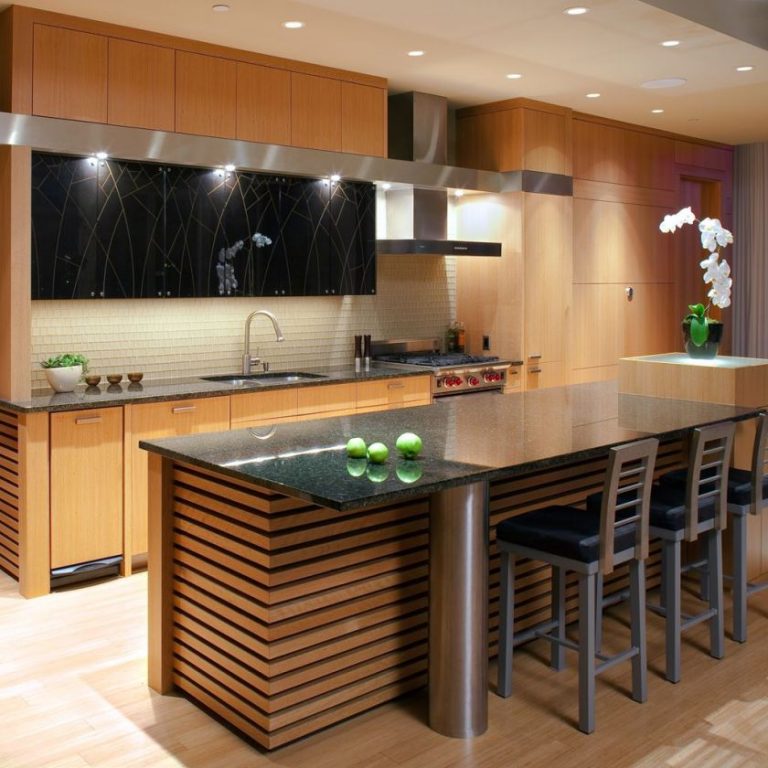
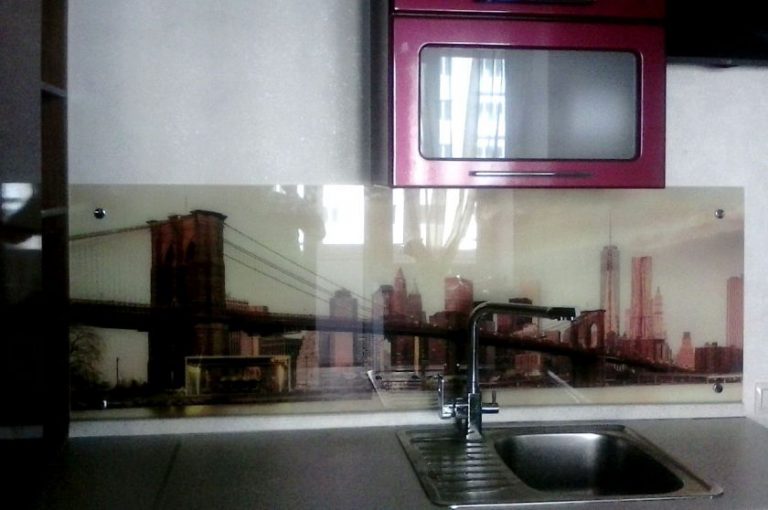
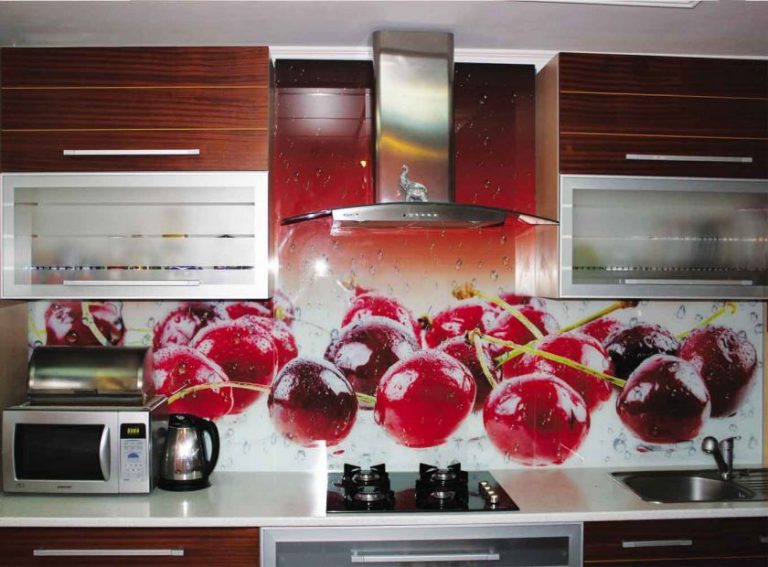
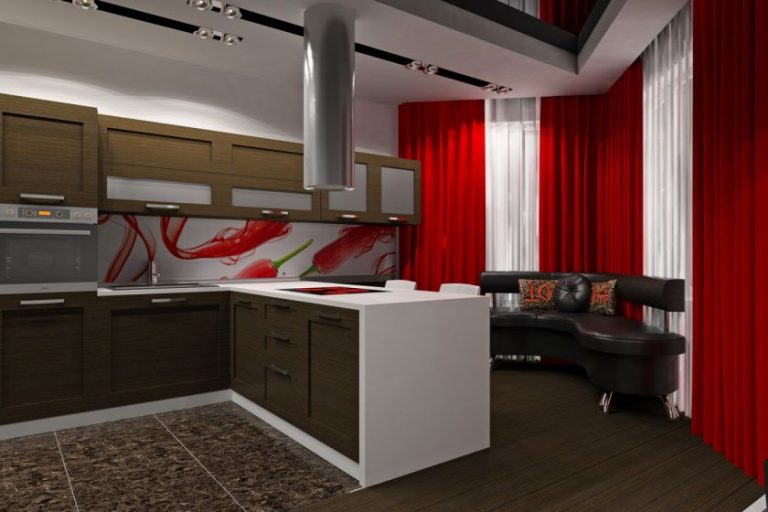
Creating a kitchen apron is an important stage in the process of repairing a kitchen, because it performs not only a practical protective function, but also serves as an important, noticeable element of decor.
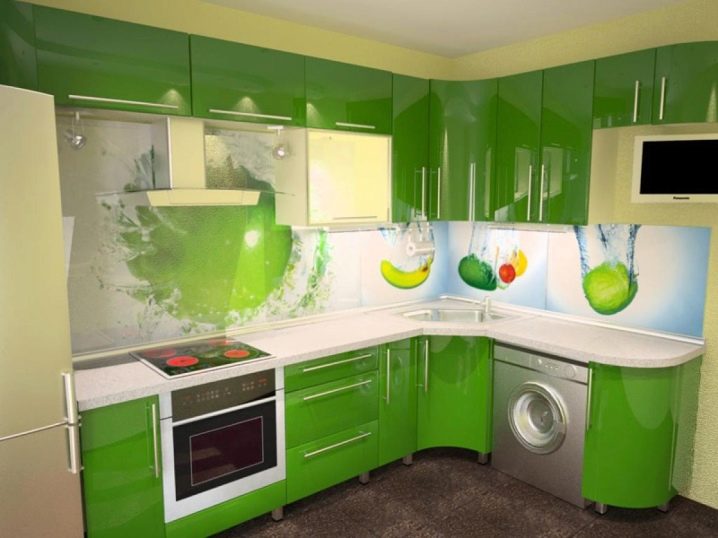
Features and Benefits
Recently, it has become fashionable and relevant to install an apron not from ceramic tiles, but from tempered glass. Such an apron has its clear advantages.
- Made to order. Every glass apron It is made in a single copy, according to the specified dimensions. You can place absolutely any image on it.
- Ease of installation. Unlike ceramic, the creation of which requires a lot of time and labor of a specialist, the installation of a glass apron usually takes no more than two hours.
- Safety. Tempered glass is impact resistant, easily withstands the weight of an adult and temperatures up to 150 degrees.
- Ease of maintenance. The glass kitchen apron is a smooth, seamless surface, making it much easier to clean than a ceramic one. Suitable for any detergents, sponges and brushes.
- The glass surface visually expands the space, which is especially beneficial for a small kitchen.
- Stylish appearance. Such a surface gives you an endless field for creativity, and will perfectly fit into any interior. It is easy to combine with any surfaces and textures already present in the kitchen.
With all the obvious advantages, the disadvantages of glass aprons include their high cost - from 4700 rubles. behind square meter(usually the manufacturer indicates the price, taking into account the drawing and installation work). In addition, it should be borne in mind that such panels cannot be reinstalled, completed or changed in them, so all the nuances, the location of sockets and lighting, must be thought out in advance.

Kinds
Currently, there are several types of tempered glass from which kitchen aprons are made.
- Stemalite. It is also called back painted glass. In the production process, it is painted with colored enamel before hardening. As a result, two inseparable layers of paint and glass are formed.

- statin. Very pretty but needs to be taken care of frosted glass. Due to the complex production, its cost is higher than that of ordinary transparent glass.

- Skinali. The most common glass panels with a special substrate with photo printing or stereo printing. The type of printing significantly increases the cost of the product. The panel with the most expensive stereo printing costs two to three times more than a regular one.
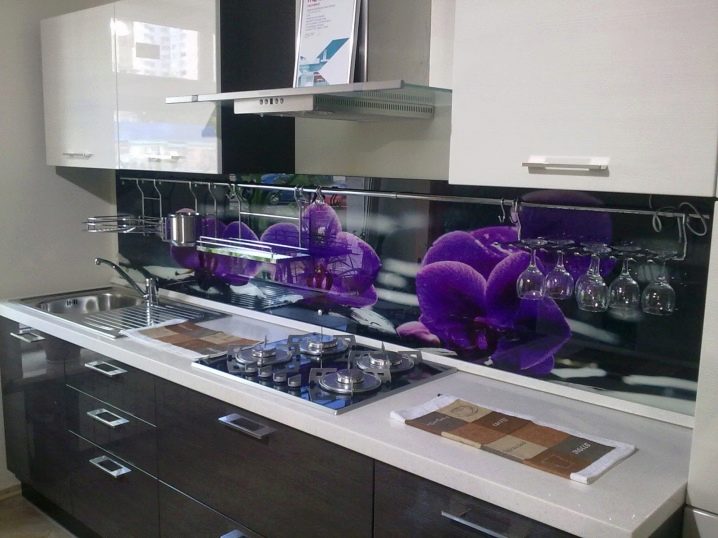
- Optiwhite. Such glass, without the characteristic bluish tint, is obtained as a result of a bleaching process. It is ideal for drawing on it light and detailed drawings with the most small elements. But such characteristics increase the cost of panels by 1.5-2 times.
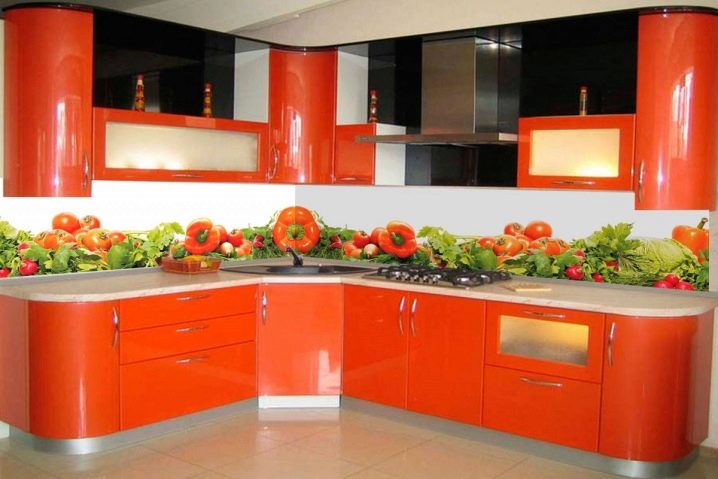
In addition to tempered, an apron with a pattern can be made from laminated glass or triplex. It is made by gluing several sheets of glass with a special polymer film. Sheets can be silicate, hardened or organic. Due to this, triplex panels are thicker than ordinary or tempered glass - 8 mm. They are also safer - in case of damage, such glass does not crumble into fragments and is very resistant to temperature extremes.
Design, pictures and colors
Glass panel production technologies make it possible to create suitable option for any interior in the kitchen of any size. Of course, you will not be able to make a glass apron with your own hands, but with the help of a designer and a craftsman, you can easily realize all your fantasies.
To get started, you should familiarize yourself with specialized image directories. It must be understood that in order to obtain a high-quality picture, the original image itself must be in good quality.
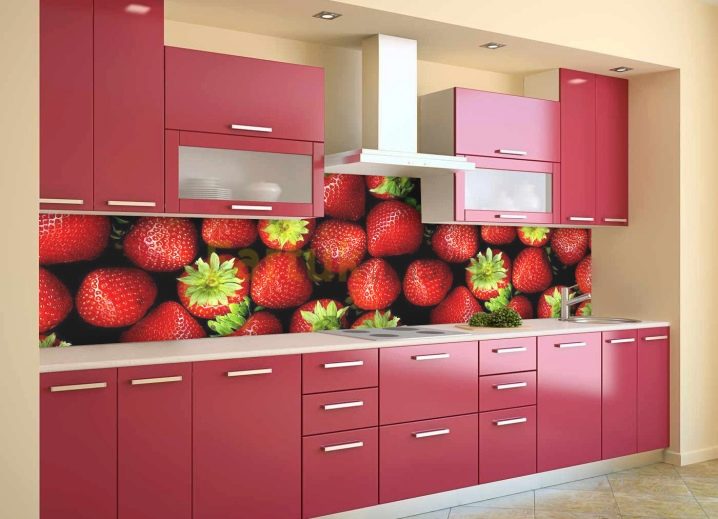
The well-known site Shutterstock offers a huge selection of stock photos suitable for skinali, corresponding High Quality. The range includes classic "kitchen" motifs - coffee beans, bright fruits, beautiful still lifes, panoramic city views, forest landscapes and even classic paintings.
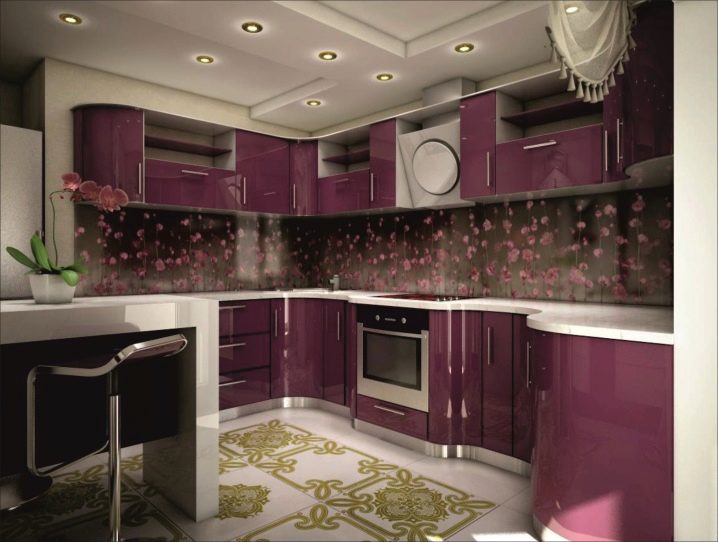
Recently, a variety of floral motifs. For example, images of orchids, characterized by juicy tones and exquisite lines. A glass apron with red, blue, pink or white orchids will inapplicably create its own unique mood in your kitchen and evoke rave reviews from guests. They also look very nice simple flowers- large daisies, dandelions, sunflowers.
Nautical motifs are no less popular. 3D images of marine fish, sharks, stingrays or bizarre shells create the effect of presence, significantly visually expanding the space.

For connoisseurs of minimalism, monochrome skinals are perfect. For example, white feathers on a black background or large black balls on a white background look extremely stylish. Ice cubes and drops of water look especially beautiful. For lovers of the original, skinali with the effect of broken glass is suitable.
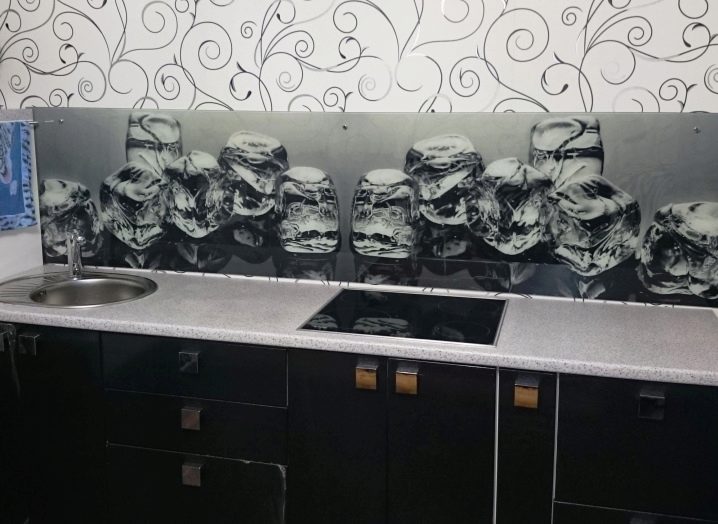
Skinals with various ornaments and textures look no less beautiful than photographs. Floral ornaments, leaves, geometric shapes, light and unobtrusive or colorful and multi-component, with Greek or Scandinavian motifs - they can also be found for every taste.
Panels look interesting folk paintings- Zhostovo elements, Khokhloma or Gzhel. They are perfect for creating an atmosphere in a rustic kitchen.
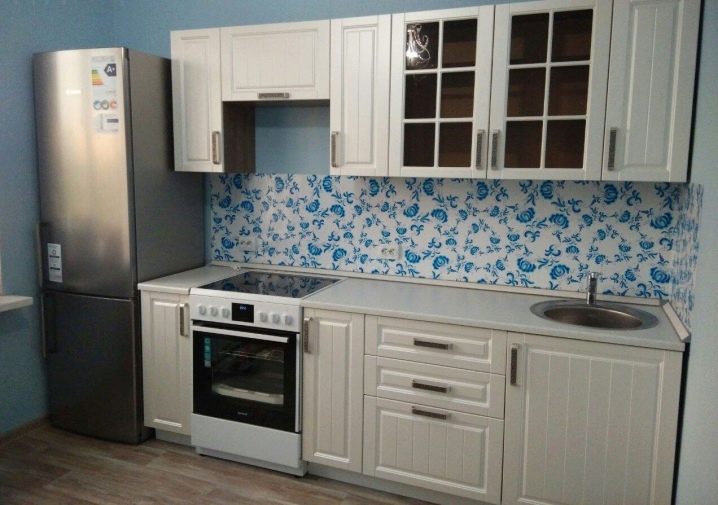
If you install a glass apron for the background, that is, without an image, then you can choose a color both to match the whole kitchen, and according to the principle of contrast. Brightness and dynamism of the interior will be given by a panel of fuchsia, light green or yellow color. If you have a bright headset, then the panel, on the contrary, is better to make it white, pale blue or completely transparent.
It is also possible to make a completely mirrored panel, but it will require special care, since drops and stains on the mirror are more noticeable than on the surface with a pattern.
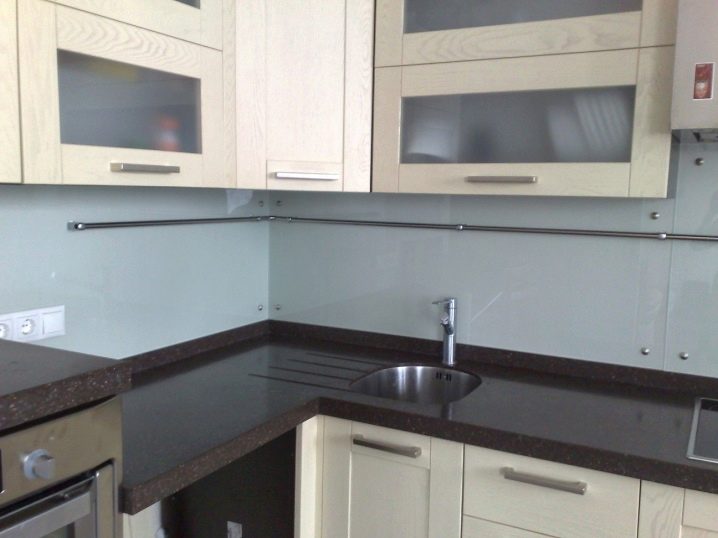
How to choose?
The variety of tempered glass panels is so wide that to make right choice is not very easy. In order not to be mistaken, it is worth considering a few facts:
- The thicker the glass, the higher its strength. Optimal Thickness- 6 mm. Some manufacturers offer cheaper aprons made of 4 mm thick stanilite. This is quite acceptable, but their strength is significantly inferior to their six-millimeter counterparts.
- The cost can be reduced due to the method of fastening and installation of a solid panel without slots. To do this, sockets and lighting must be taken out of the apron area.
- Do not rush to choose a pattern. Study the proposed catalogs, and choose an image based not only on its beauty, but also on the overall design of the kitchen. Otherwise, you can only destroy the integrity of the interior.
- If you are in doubt about your choice, then if possible, print the image on paper and mark it on the wall. This way you can be sure that the option you choose is right for you.
The kitchen can be not only a place for cooking, but also a cozy embodiment of the hearth. Much depends on how convenient it will be for the hostess to work here, and for friends and relatives to gather at a common table. So there is a growing demand for original interior elements that not only provide comfort, but also improve the aesthetic appeal of the design. It is such a spectacular decor that photo printing for an apron for the kitchen can become. How practical this finish is, and how to choose the right materials for it - we will consider in detail.
Protecting the walls next to the sink, stove and worktop is a challenge for materials with excellent heat resistance and easy care, which is why the classic finish has long become ceramic tile. But progress does not stand still - new coatings appear that are quite capable of competing with the market leader in terms of performance, and even overtaking it in terms of design attractiveness. Consider the most popular varieties of the basis for aprons with a pattern.
The pattern on the finish can radically transform even an inexpressive design:

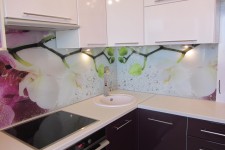
Plastic wall panels
Inexpensive plastic products gaining popularity every year. This is facilitated not only by the price, but also by the constant improvement of quality. A thin lining a la "hello from the 90s" has long sunk into oblivion - today for manufacturing wall panels And sheet materials for kitchen aprons with photo printing, the following types of plastic are used:
- PVC (hard polyvinyl chloride);
- PMMA (acrylate, organic glass or plexiglass);
- Polycarbonate (carbonate glass).
All three materials meet the requirements kitchen atmosphere— resistant to moisture, hot steam, household chemicals, temperature, are highly hygienic and practical. In addition, plastic panels are lightweight, which makes it easy to install them with your own hands.
On a note! Strength characteristics acrylic and carbonate are best - even with strong blows they do not break into fragments, however, they can crack.
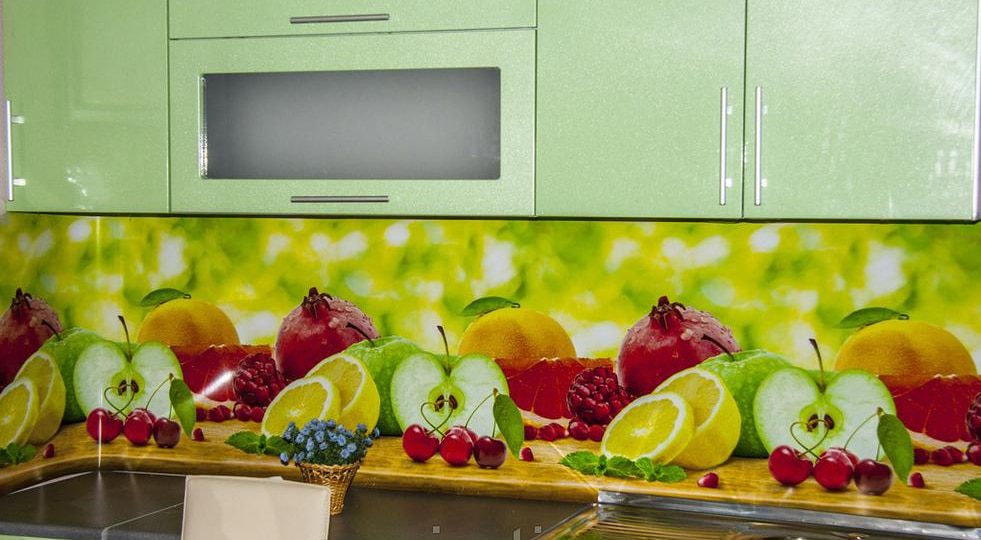
Appetizing fruit and berry motifs
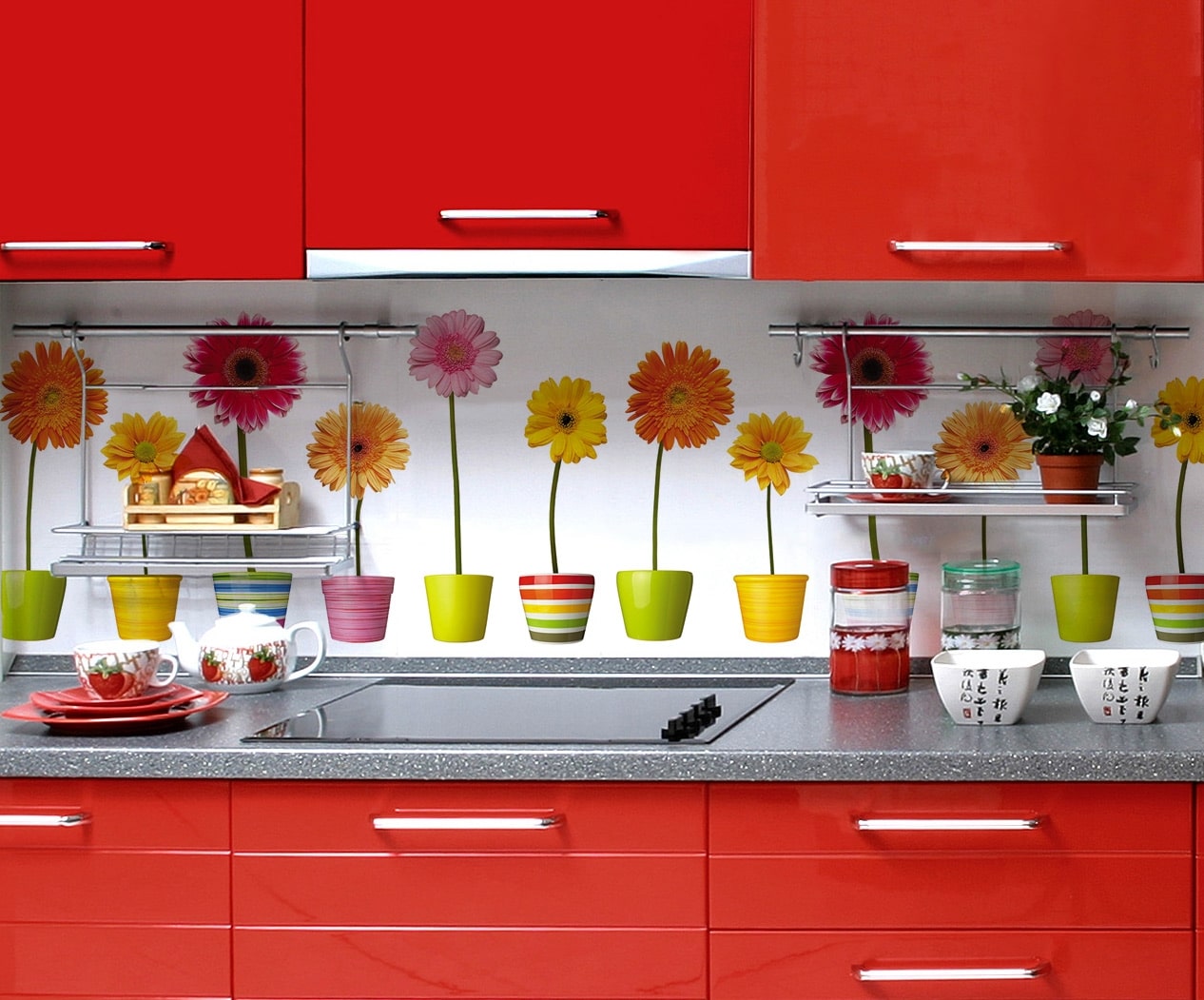
Bright polycarbonate apron
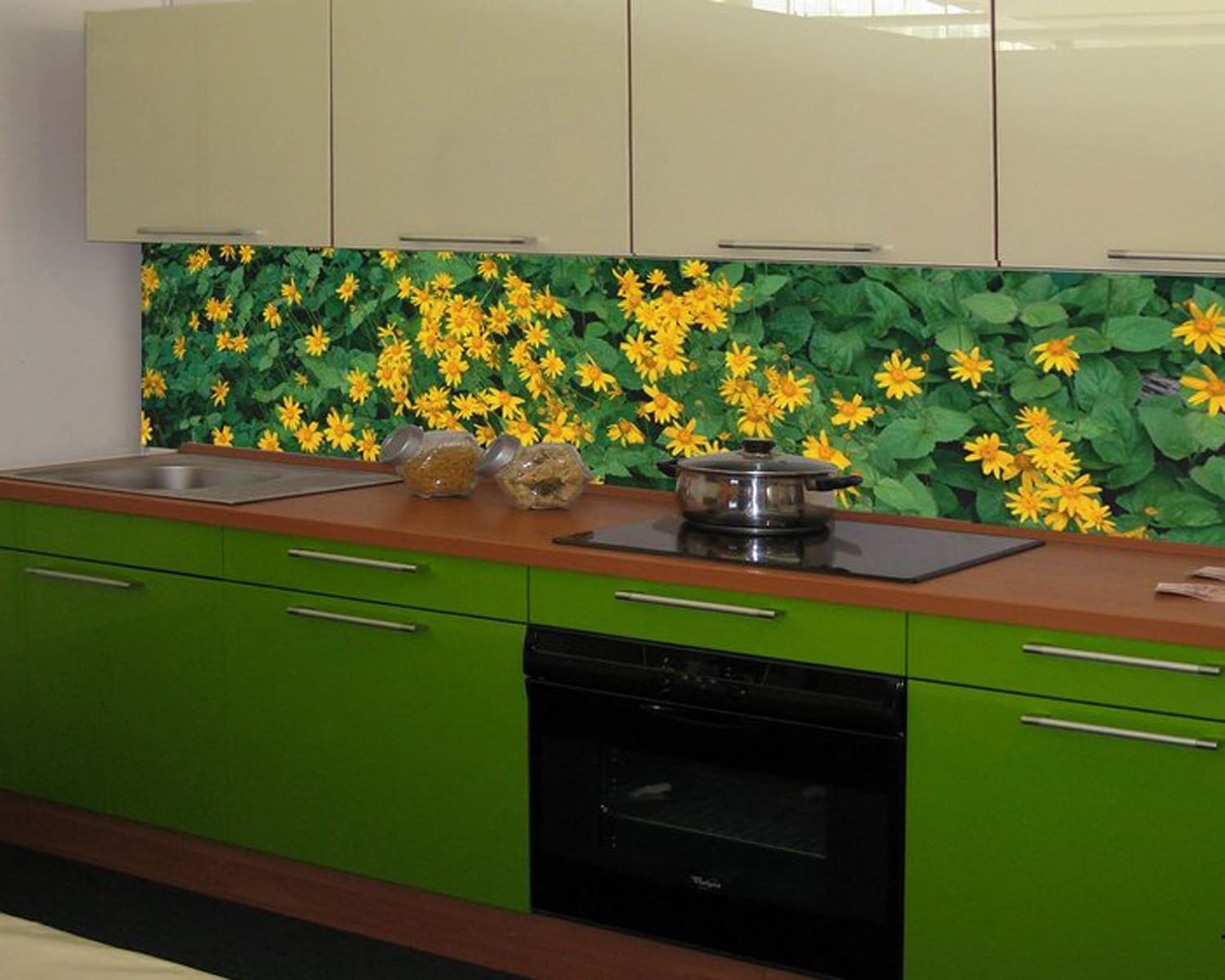
Realistic 3D printed plastic panel
Even flaws plastic panels can be offset by compliance simple rules operation:
- When cleaning, do not use abrasives, alcohol solutions and acetone, as well as hard brushes, and the surface of plastic aprons for kitchen with photo printing will be free from scratches and faded matte areas.
- In time, wipe the panels from splashing water (especially if it has a high salt content) dry soft cloth- this will save them from the appearance of ugly divorces.
- Do not install the apron with photo printing close to the stove to avoid deformation from exposure to high temperatures.
As you can see, plastic can also be used to obtain a practical, stylish and very budget interior. Of course, the price of the panel increases in proportion to the increase in the strength of the material, and the polycarbonate apron will not be as cheap as the PVC panel. But compared to other materials that are used as the basis for photo printing, plastic covers much better and more practical.
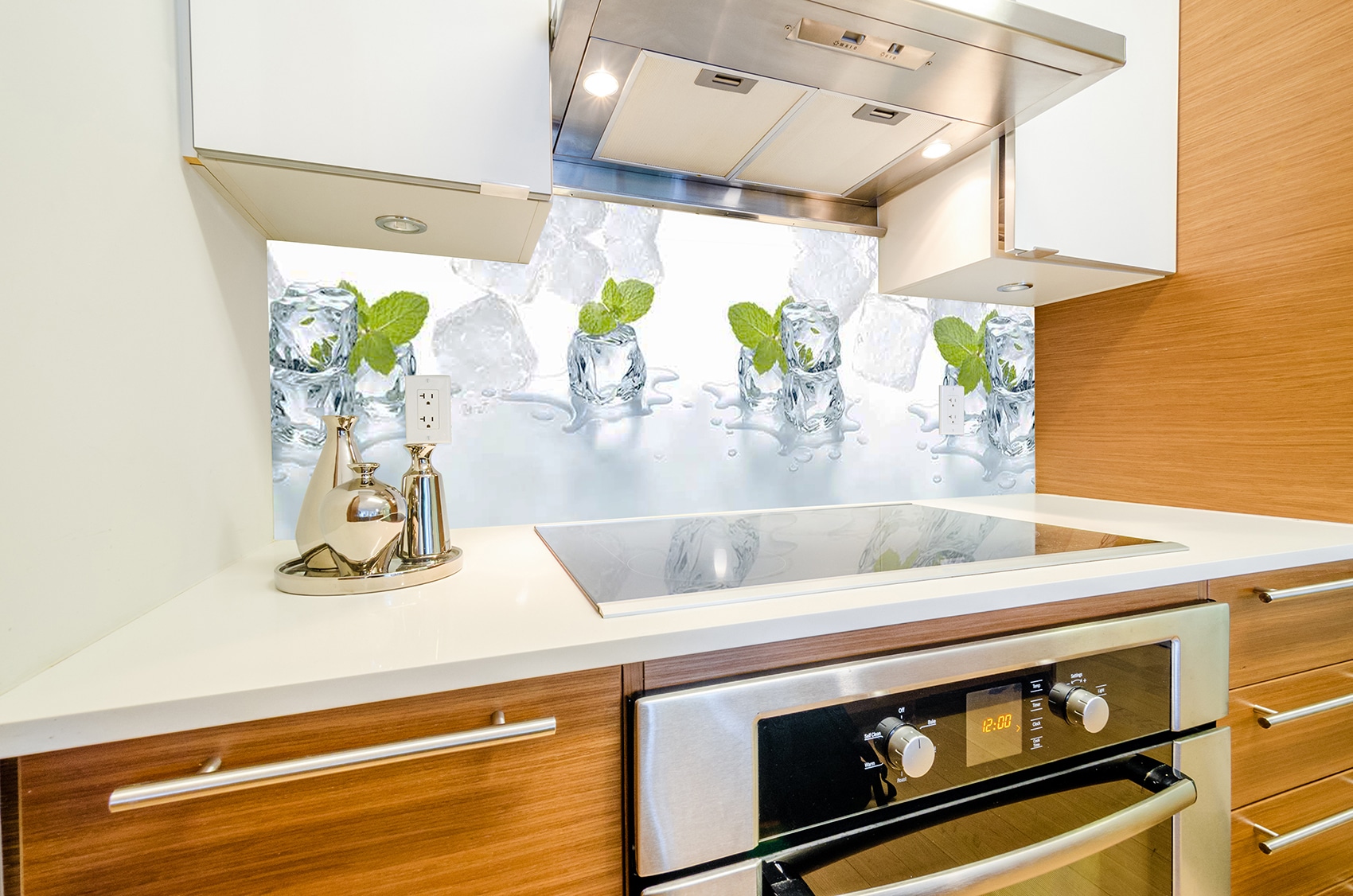
Plastic- perfect solution For budget repair
MDF kitchen apron
In the middle price category, MDF panels are presented - medium density fibreboard. Due to the manufacturing method (hot pressing of small sawdust, creating a plate bound into a single whole by the lignin released during the process), the material is durable, relatively light in weight and provides good heat and sound insulation. Although the hygroscopic index of MDF is much less than that of natural array, without good protection, such a finish will not last long in working area kitchens.
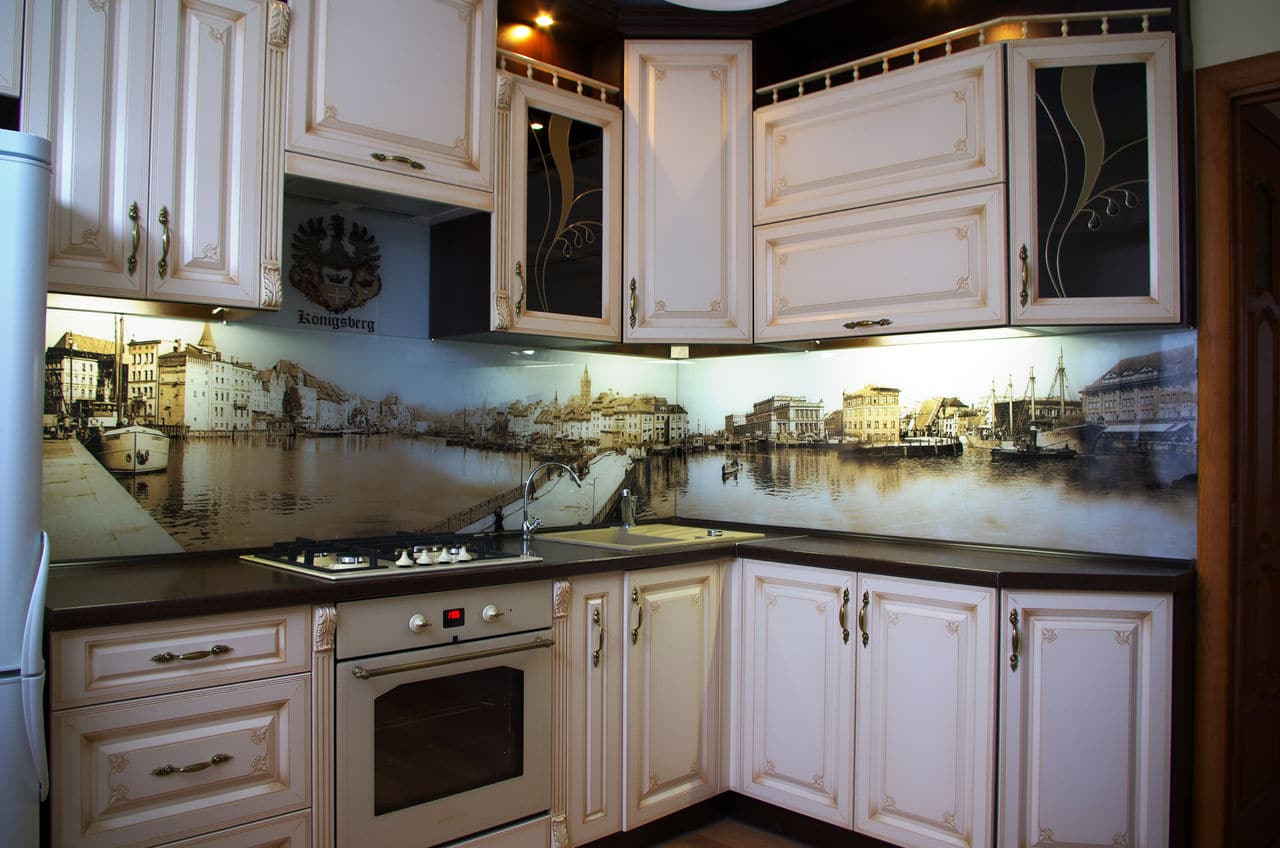
MDF apron with vintage pattern
Performance characteristics kitchen apron made of MDF with photo printing depend mostly on the type of coating and the method of its application:
- Lamination is a surface treatment with a binder, which, during thermal polymerization, literally fuses with the slab array.
- Film - pasting the panel with a PVC or acrylic film using a membrane-vacuum press.
- Acrylic - a thick layer of transparent thermoplastic polymer, which is glued to the surface of the plate by vacuum pressing.
On a note! Least practical material considered film-coated MDF - over time upper layer lags behind the base, due to which both protective and decorative properties apron. Also, the durability of fiberboards depends on how well the ends of the panel are sealed.
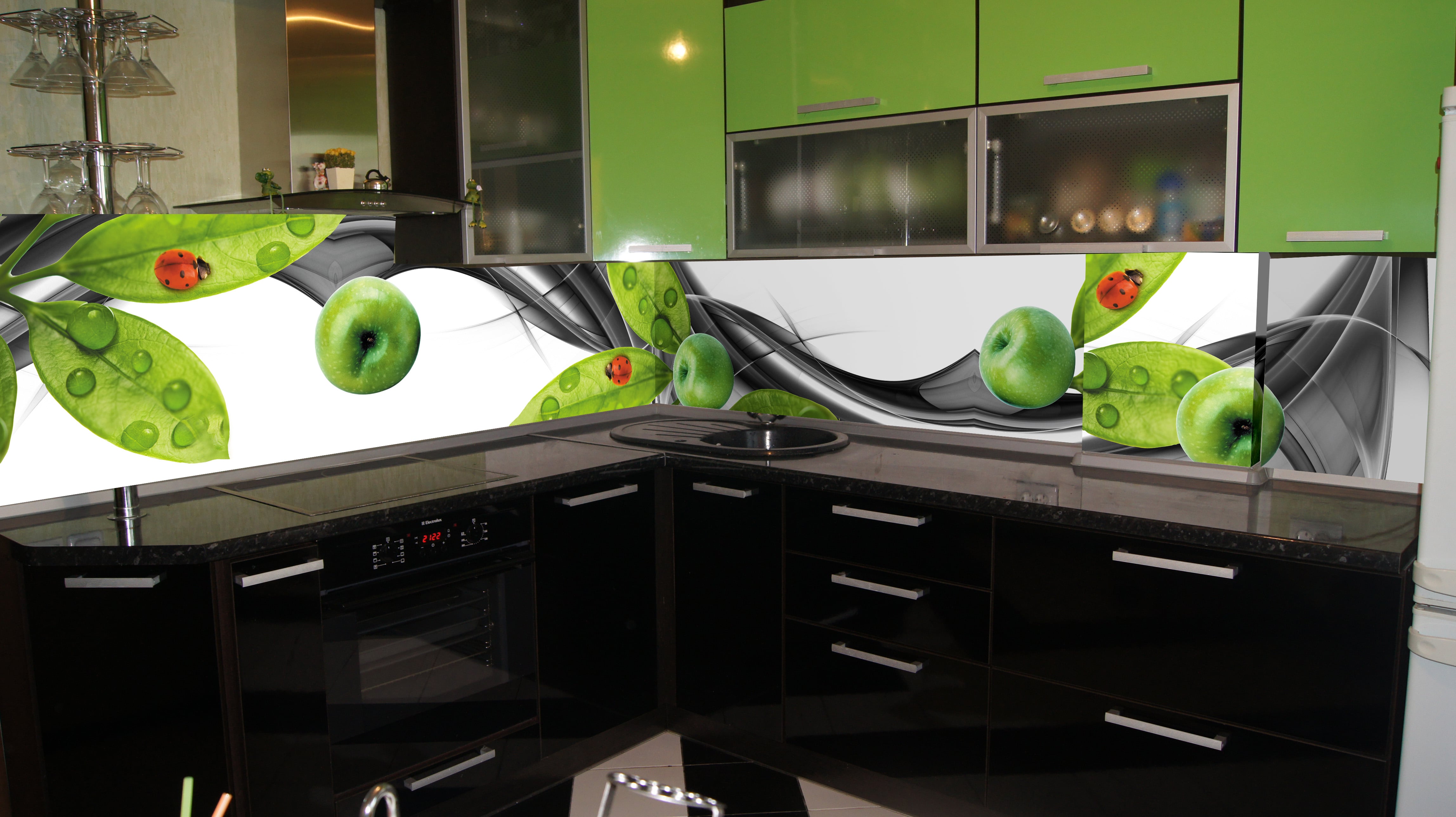
Photo printing on film inexpensive option MDF apron
Glass skinali
Glass is an almost ideal material for finishing a kitchen backsplash in terms of hygiene and ease of cleaning. But it has three significant drawbacks: high price, complexity of installation and fragility (although the last minus is deprived of skinals that have been quenched at high temperatures).

An apron can be designed in several ways:
- The picture behind the glass is the simplest and most affordable variation of skinali, which you can make yourself if you close it. glass panel beautiful wallpaper or an author's collage of photos.
- Applying vinyl film is another a budget option design of the working area - they were skinned with a pattern printed on a photo printer and glued to the surface of the panel.
- Printing on glass - using a UV printer, a photo is applied directly to the outside of the glass, making the drawing look as bright and realistic as possible. It is these aprons that are used for finishing premium interiors.
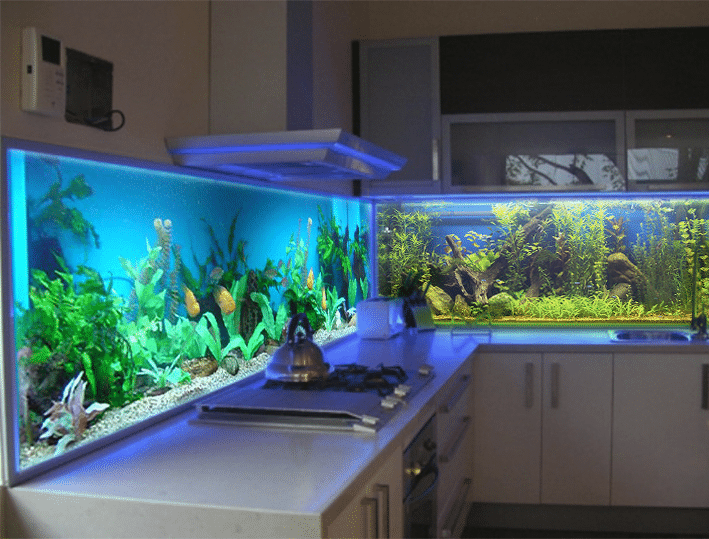
Skinali allows you to create amazing imitations
Important! High-quality skinals are made only from multilayer sheets that can easily withstand heating up to 80 degrees. Hardening increases the strength characteristics of the panel by 3-5 times.
General photo printing technology
Applying various patterns to trim elements is a win-win technique for creating unique interior. Of course, the talent of the artist and the author's painting by hand are now beyond competition, but the ability to get a perfectly clear image and apply it on a solid basis has become the key to the recognition and success of photoprint technologies. Although there are nuances here - depending on the choice of sketch overlay technique, kitchen aprons with photo printing will differ significantly in image quality and durability.
Image on film
The simplest option for photo printing is to print an image on polymer film which can be attached to a flat surface. This technique is recognized as universal and is used for any bases.
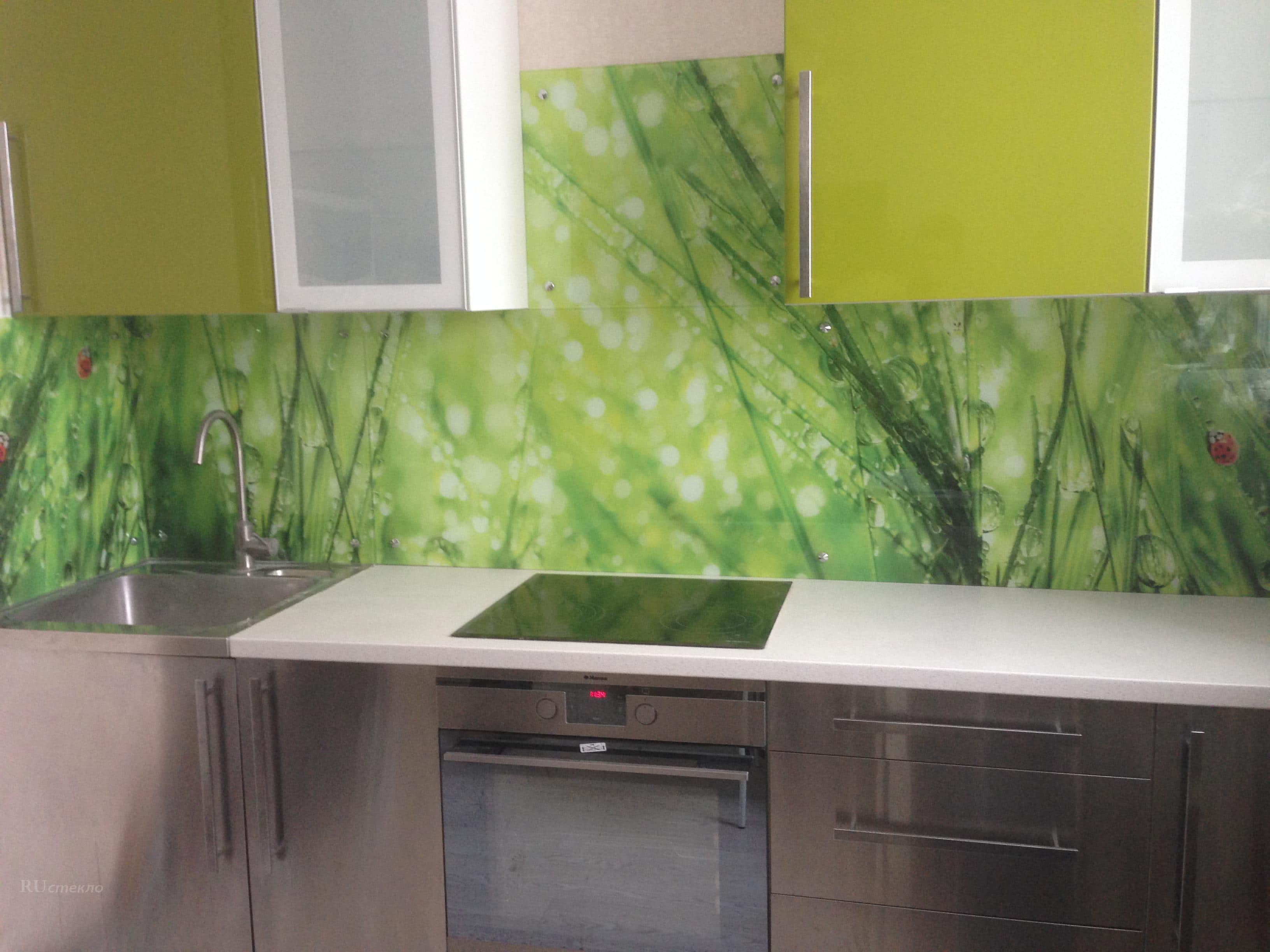
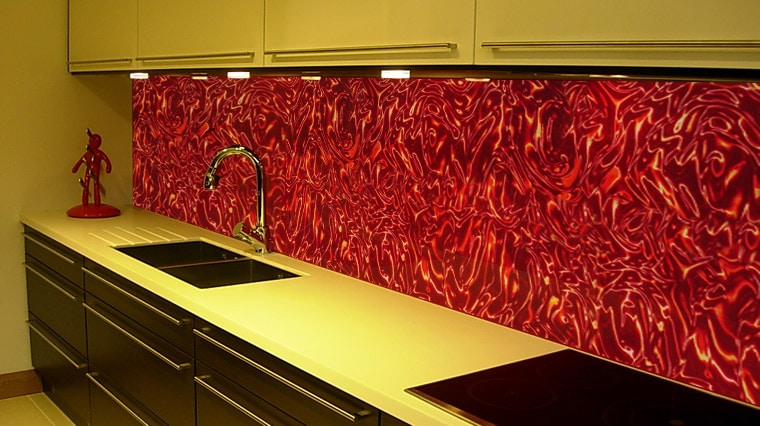
Plastic apron with film decor
There are two ways to apply film photo printing:
- on the outer surface - with opaque materials of the apron;
- on the wrong side (if the panels are made of transparent plastic or glass).
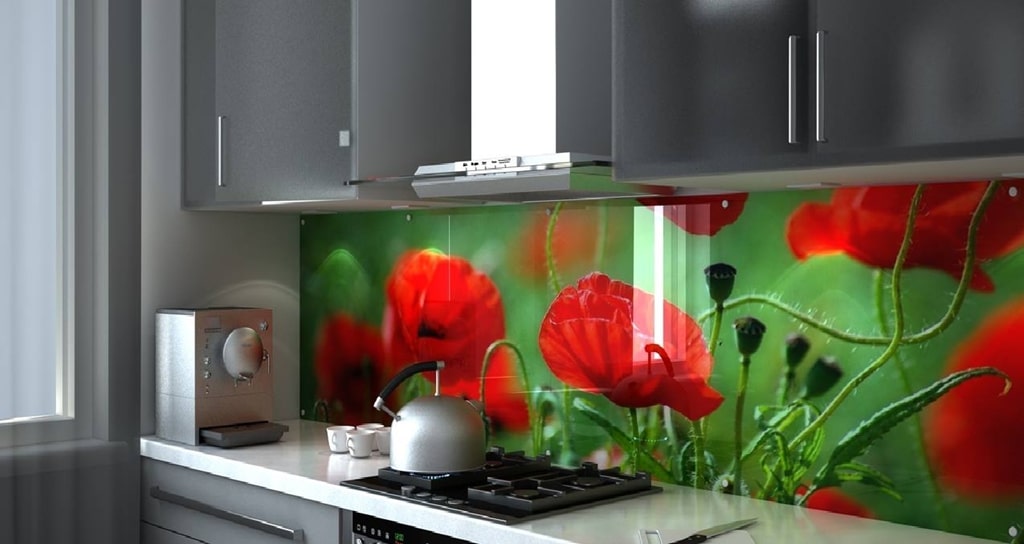
When applied to inside film will last longer
In any case, it is recommended to cover the film photo print with an additional layer of varnish or other protective agent to increase resistance to aggressive effects of moisture and temperature. But even with such a precautionary measure, aprons with photo printing will not last long (an average of 5-6 years).
Interesting! An exception in the service life of a film photo print is triplex. For the production of a shock-resistant decorative panel, a film with an image is placed between layers of tempered glass, which significantly increases the durability of the glass splashback.
Direct photo printing
Applying an image directly to solid foundation called direct printing. This method is suitable for any materials (paper, polymers, wood boards, glass, plastic), but before applying the surface requires additional processing- cleaning and degreasing.
Depending on the type of ink, there are two printing methods:
- In the UV method, inks with a polymerization effect are used, which harden under the influence of ultraviolet radiation. For better adhesion of the ink to the substrate, a special chemical reagent, a primer, is applied before printing.
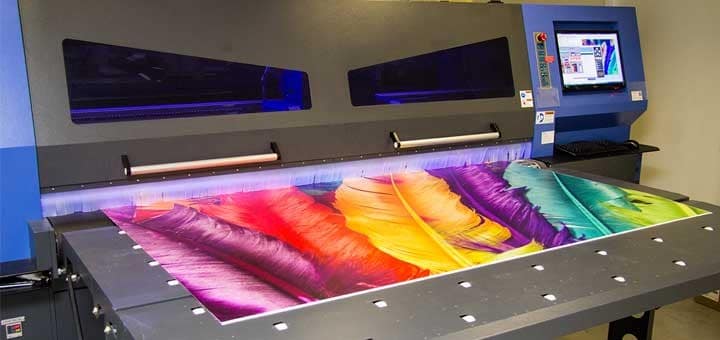
UV printer at work
- For solvent printing, special inks (nano-inks) are used, which have the ability to penetrate deep into the material and reliably bond even with a base that is characterized by low adhesion rates.

Both types of paints give bright and saturated colors. Images are resistant to water, grease, chemical substances and mechanical abrasion, so they do not require an additional protective layer.
Interesting! When drawing a picture on both sides of a transparent base (mineral or organic glass), a three-dimensional image appears.
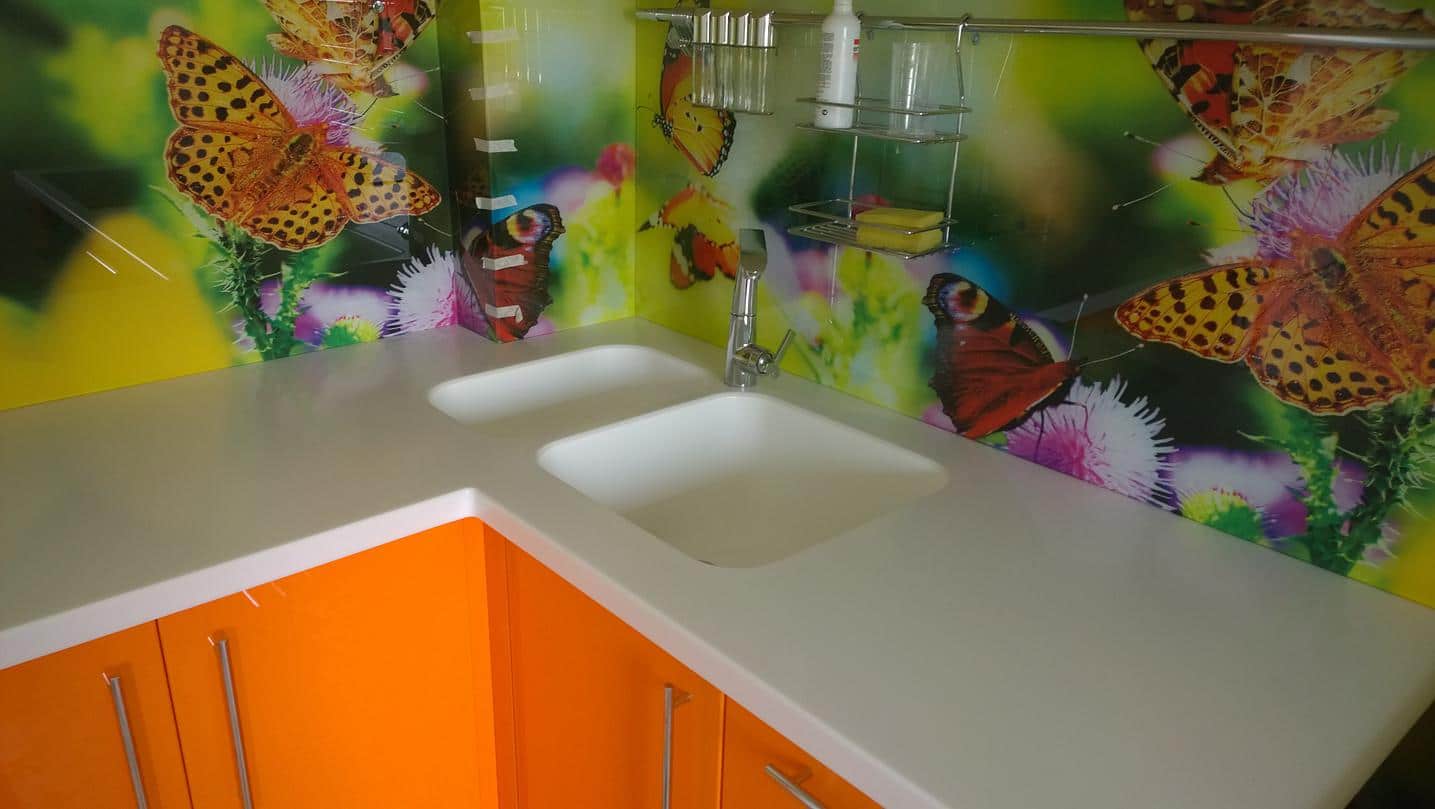
Bright apron with 3D effect
Applying images using the HOT COATING method
The method of "hot facing" (hotcoating) is most often used for photo printing on MDF. The image is applied to the base with a viscous hot adhesive composition, which is additionally treated with several layers of thermoplastic varnish with a high degree of gloss. After cooling, the coating becomes almost monolithic with the base, which significantly improves the quality characteristics of the MDF panel.
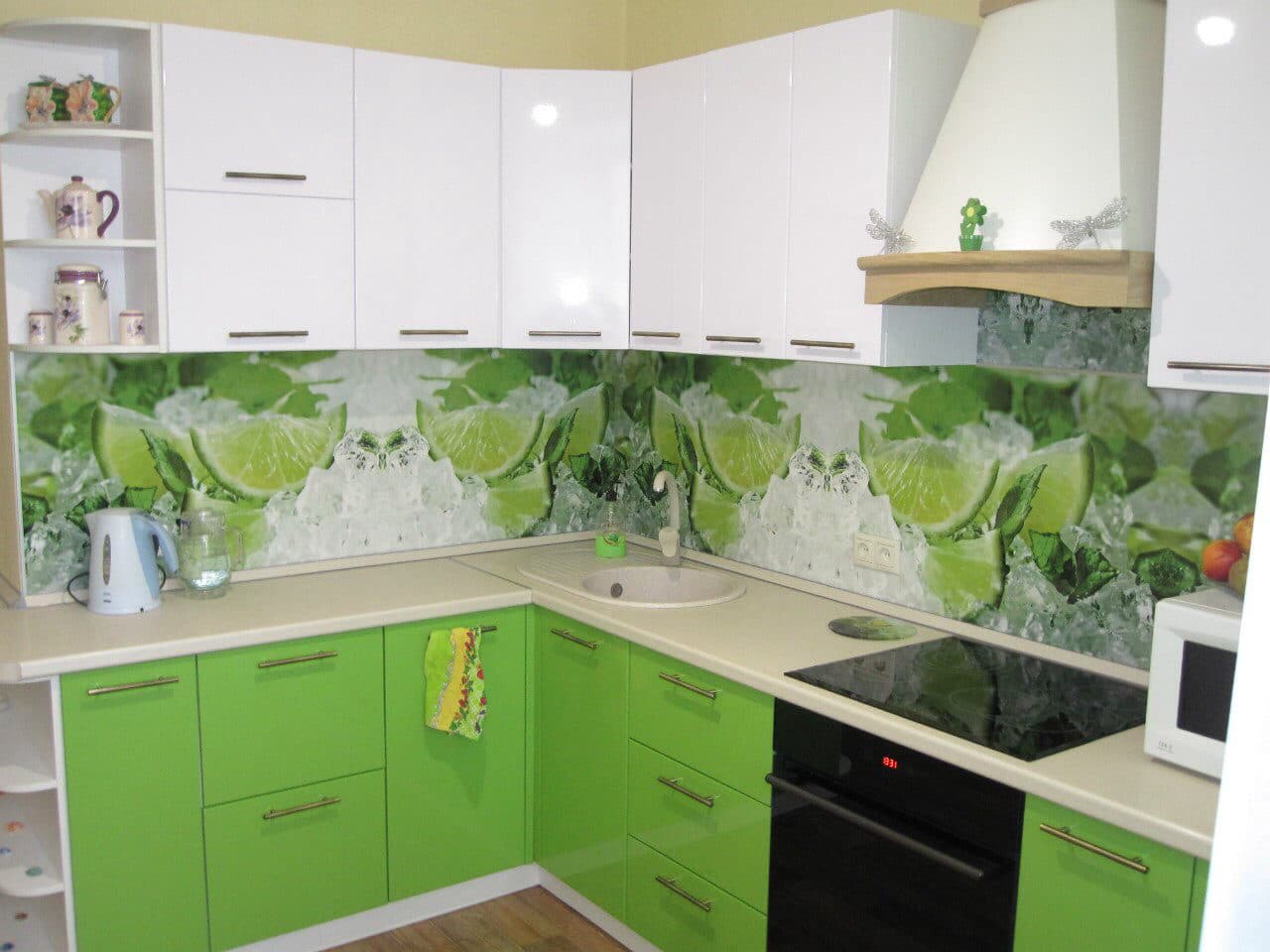
High gloss aprons made using HOT COATING technique
Nuances of ordering your own images
The spread of photo printing technologies has led to the emergence of huge selection ready-made templates under various color solutions and interior styles. In addition, anyone can order a unique image from their own photographs. However, before calling the right company with a sacramental “I want”, it is necessary to clarify whether the selected picture meets the production requirements.
The most important characteristic of the original image for a high-quality photo print is its resolution, which must be at least 300 dpi. That is, for an image measuring 10 by 15 cm, you need a resolution of 1200 by 1800 pixels - lower-quality images (fuzzy or blurry) lead to noticeable graininess.
Important! Although the image can be anything, you need to consider how compatibility with common interior kitchens, as well as the arrangement of color fragments on a sheet of glass, plastic or MDF with photo printing. Pay close attention to the last remark - if instead of bright element suddenly there is a socket or other functional hole on the apron, then the aesthetic effect of the updated design will be spoiled.
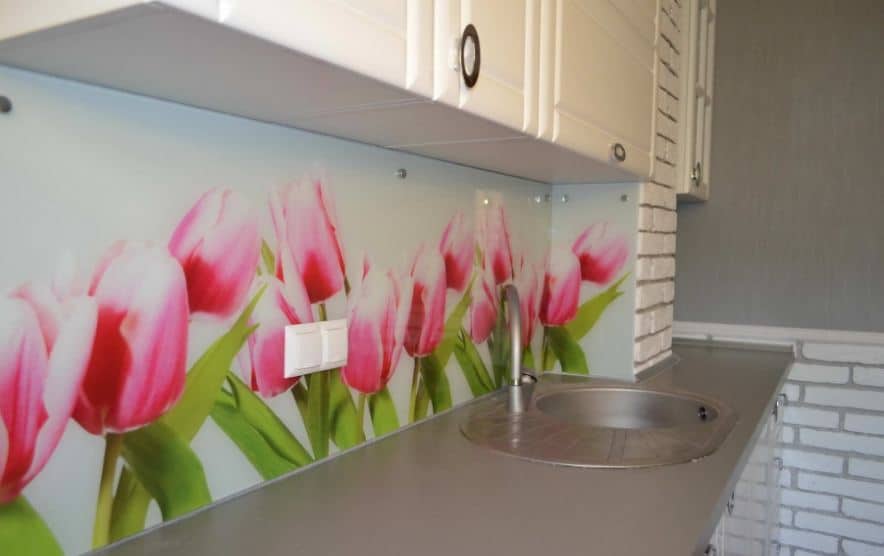
Unfortunate location of switches right in the picture
When choosing the theme for the design of the apron on your own, it is easy to get confused in a wide range of tempting offers and choose an image that looks great in a catalog or at a sample exhibition, but does not fit the interior of your kitchen at all. Therefore, before buying, it is worth at least in general terms decide on the plot and range of future finishes.
Things to consider when choosing a color:
- For small, narrow or shaded kitchens, it is best to use light neutral tones and glossy finishes - then the room will seem more spacious, filled with light. And do not forget about the illumination of the working area.

Additional lighting - a practical element of decor
- If furniture fronts, finishes or textiles are already decorated in bright or dark colors, for an apron it is better to use neutral bright hues or black and white images.
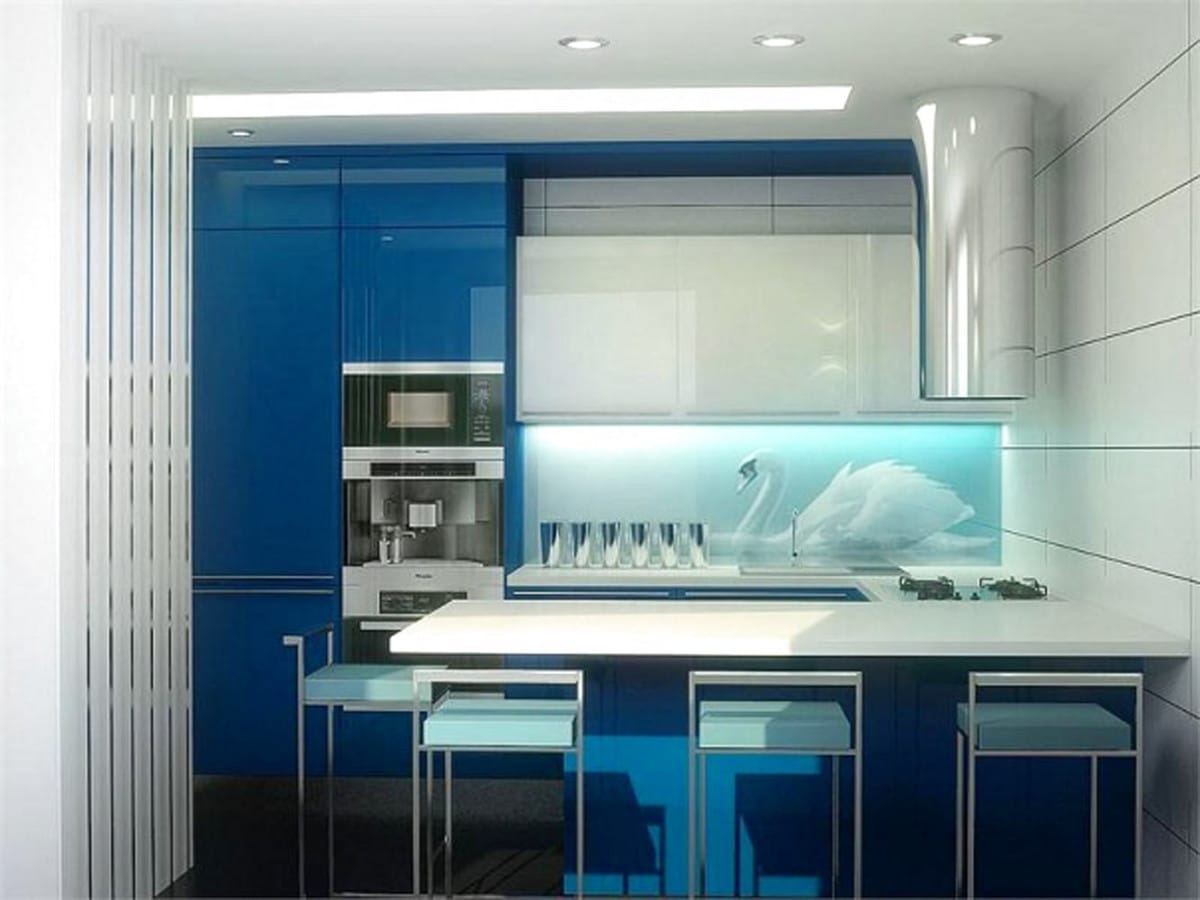
A good solution is a light decorative panel in the same range with bright facades.

The perspective effect takes the eye away and goes well with dark facades.
- The aggressive color of the apron can quickly become boring, especially if the rest of the design elements are kept in soothing colors. Therefore, it is better to choose a neutral background and complement it with colorful details that are combined with a palette of accessories, dishes, textiles, furniture fittings, etc.
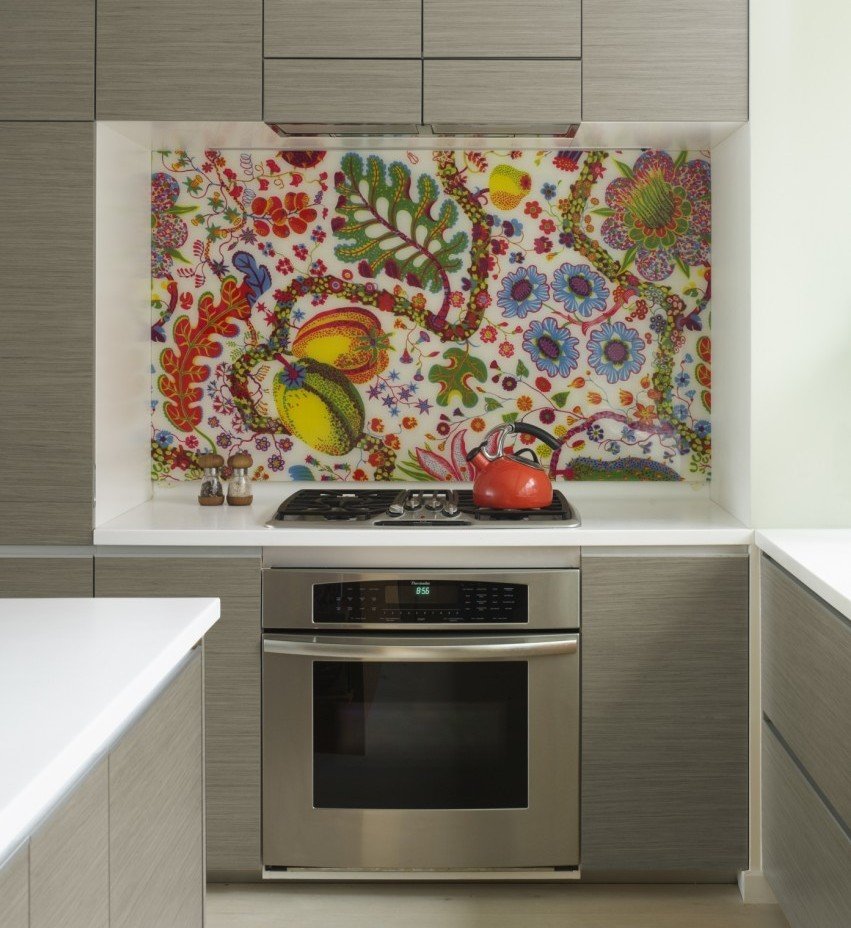
Accent apron in the kitchen in neutral colors
- If you are not afraid of the abundance of colors, you can choose a plot where there are elements that match in shade with other bright decor.
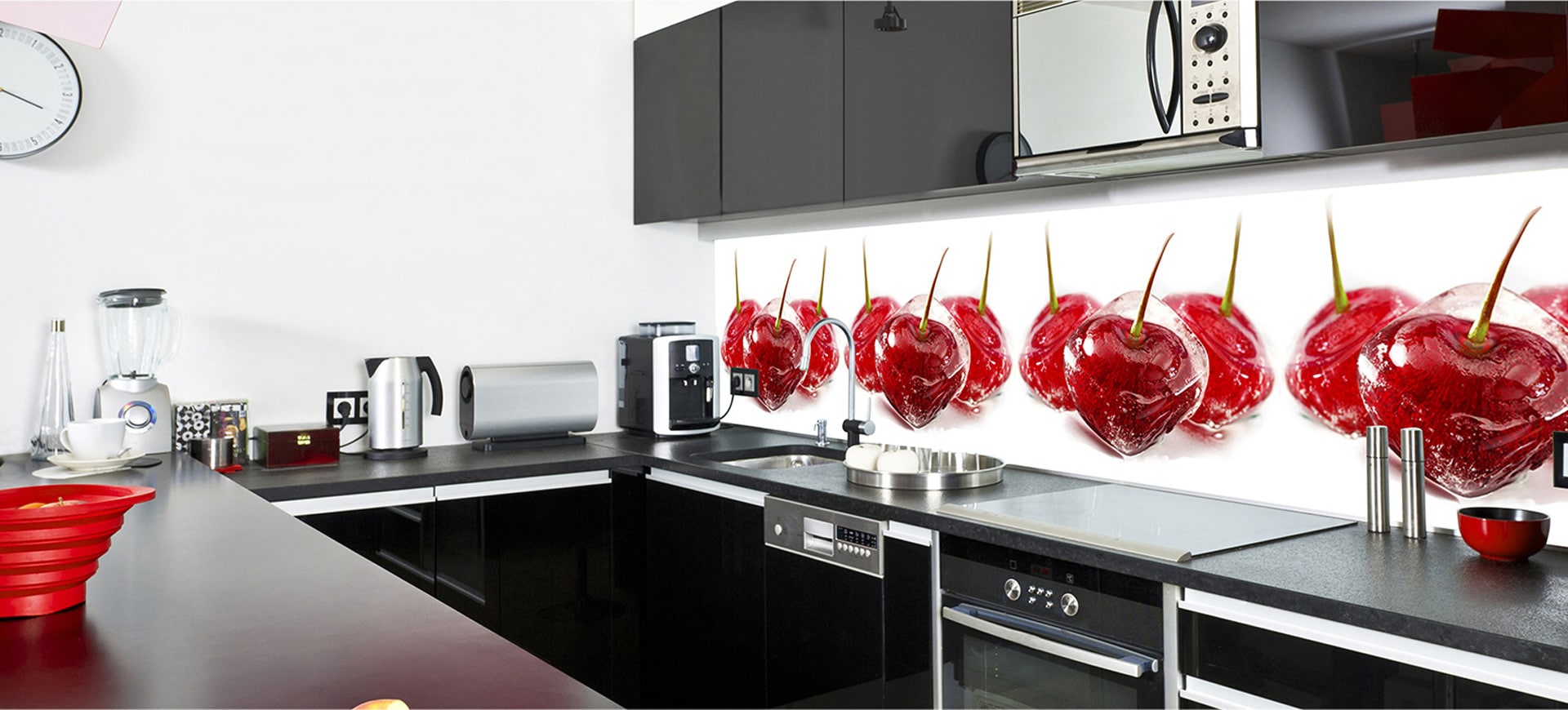
Bright accent solution for black and white kitchen
Bright scenes, matched to the facades of the kitchen:
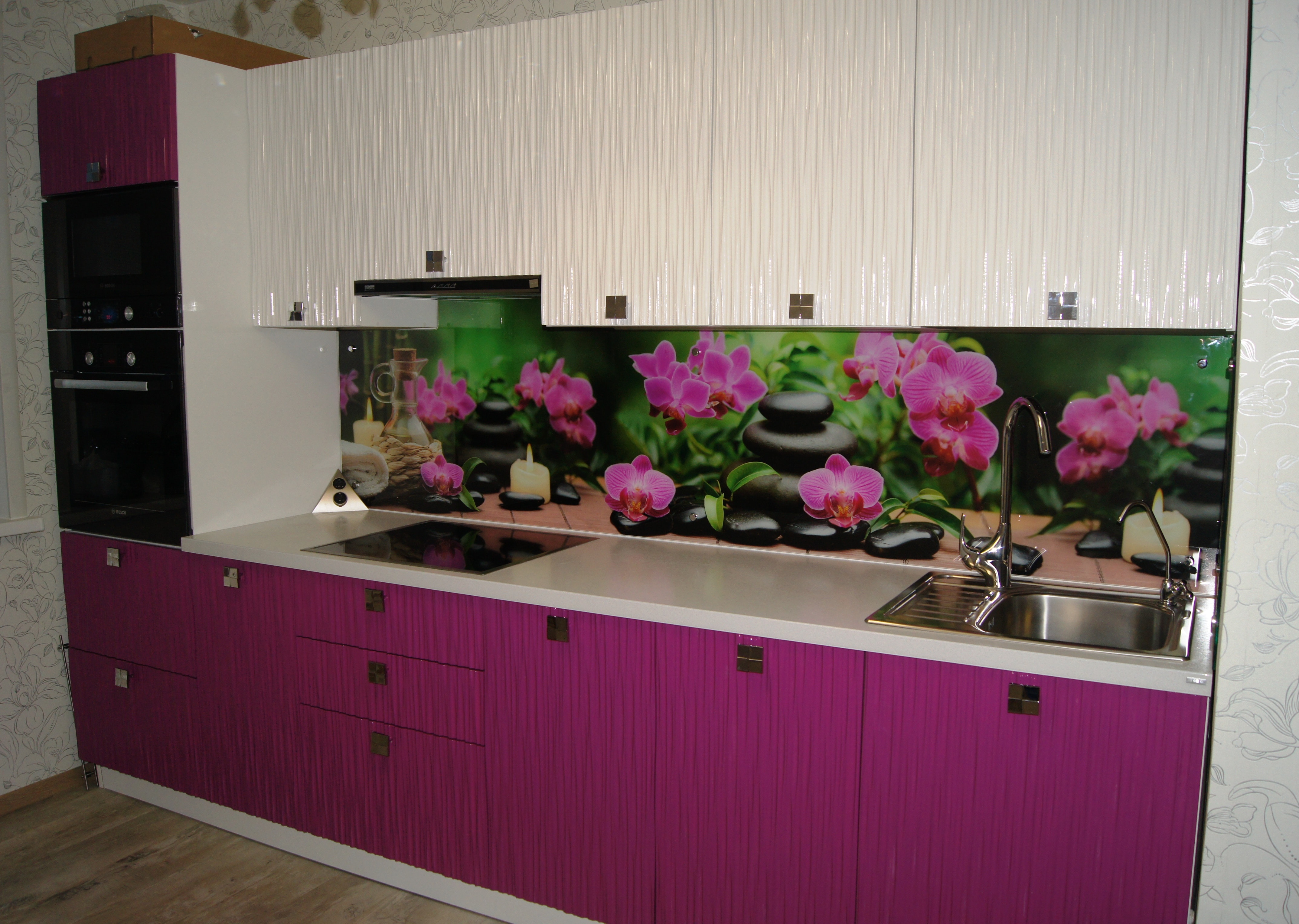
Choosing the most suitable color scheme, it is worth thinking about the image itself, which will be applied to the apron with photo printing. Any picture should not only be in harmony with the rest of the elements and the style of the kitchen interior, but also correspond to the mood and worldview of the owners.
Most popular solutions:
- Floral motifs - a versatile option with rich natural colors, among which it is easy to choose suitable tones for decorating the kitchen. delicate flowers and bright greenery will bring to the interior modern kitchen notes of playfulness, comfort, femininity and romance.
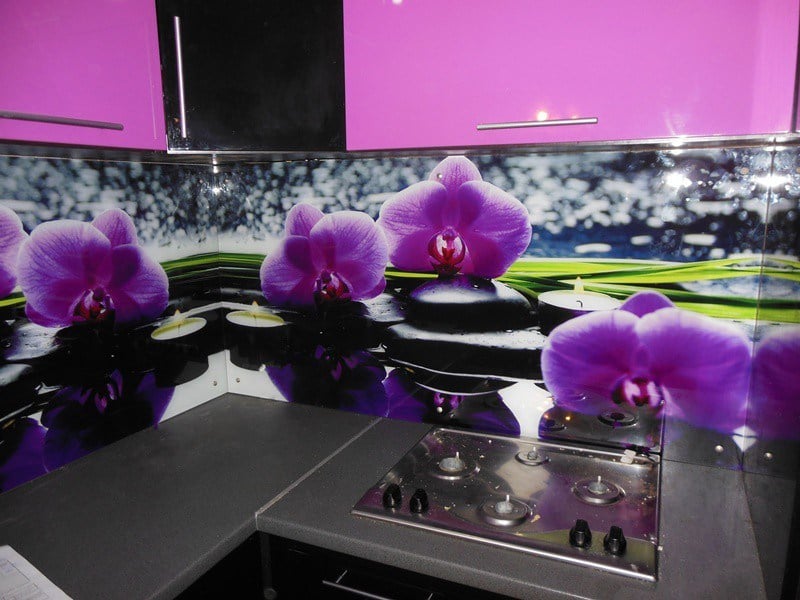
bright orchids

Flower apron and well-chosen accessories
- macro effect. Kitchens in modern style With big amount techniques are perfectly combined with large images. These can be paintings on a culinary theme (fruits, vegetables, beautiful dishes, coffee beans or a scattering of spices), various plants or representatives of the world of fauna.
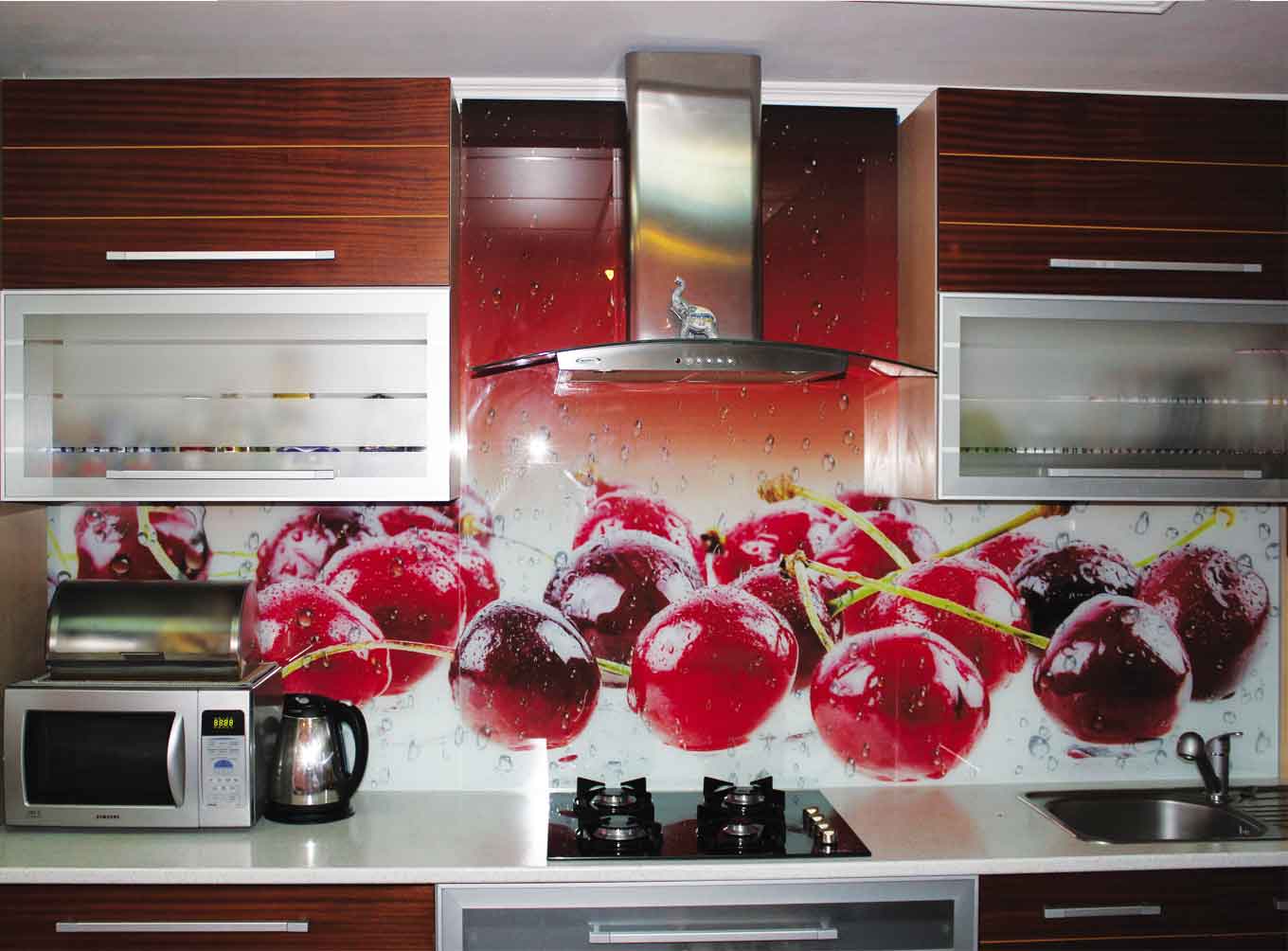
The richness of the color is emphasized by the macro effect
- Urban and natural landscapes - cozy streets with magnificent architecture, mysterious depths underwater world or endless panoramas will become a window to another dimension, which will visually push the walls of the room and mentally transfer you to the most beautiful places on our planet.
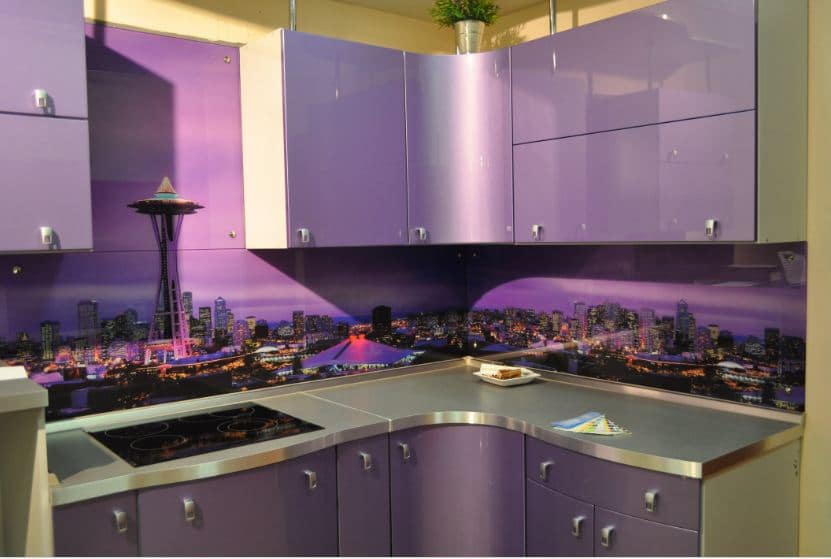
Night city lights
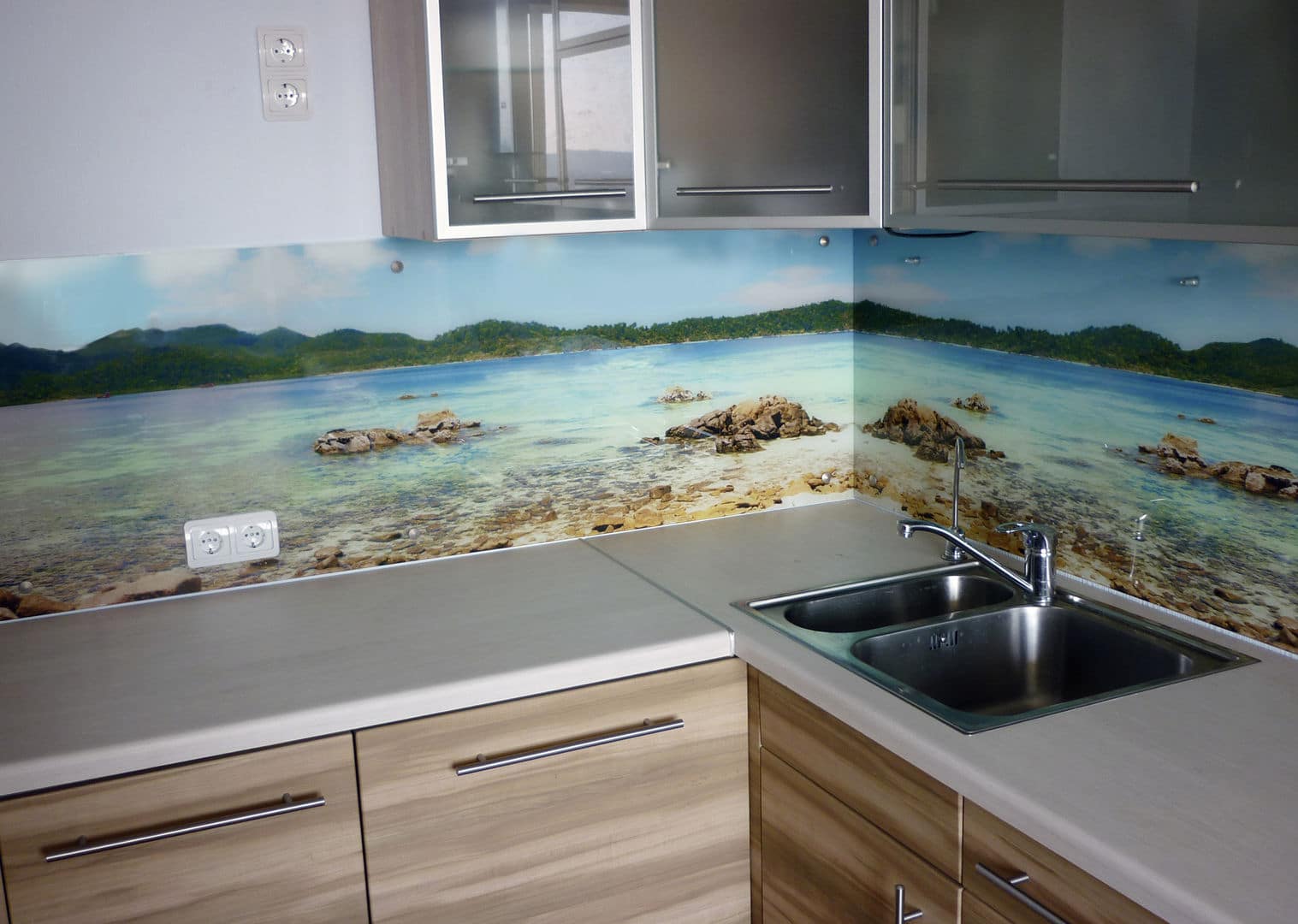
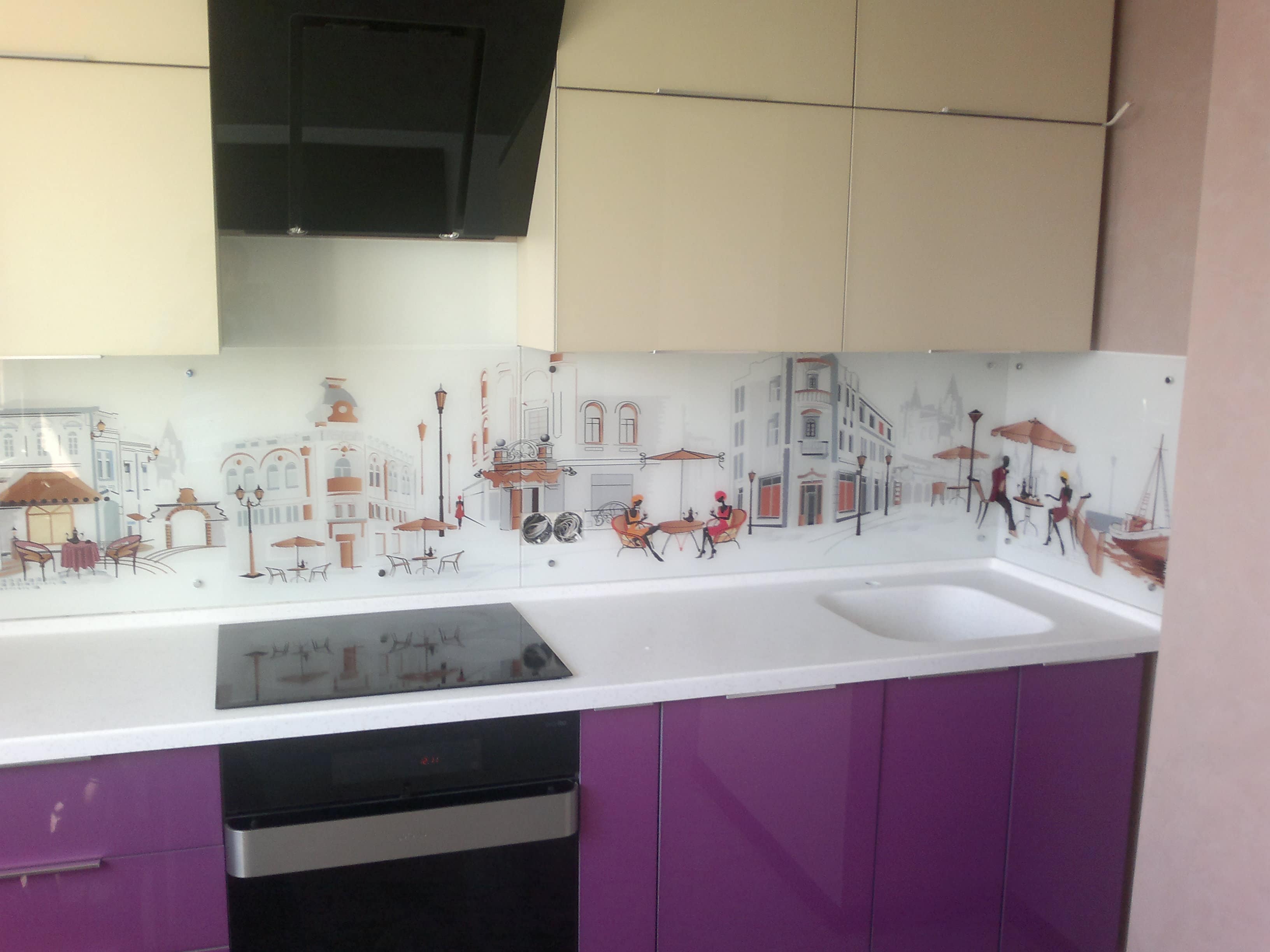
- Abstractions - paintings with a pattern from geometric shapes, bewitching illusions of chaos or paintings in the spirit of expressionism will appeal to creative individuals.

Stylish kitchen with glass panels
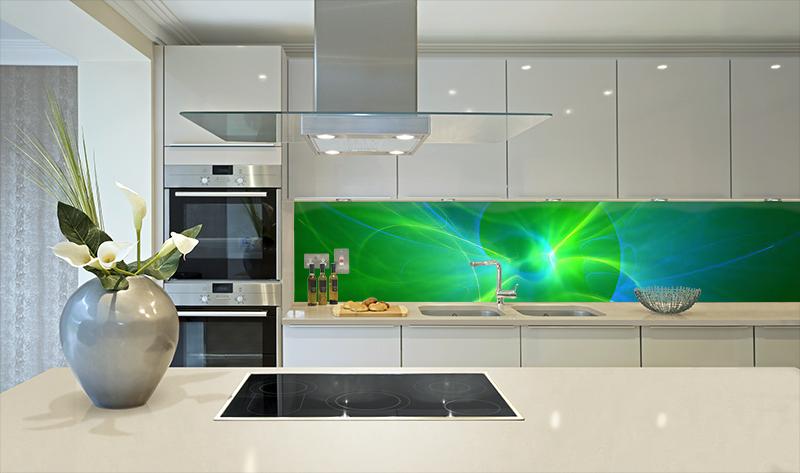
Important! Do not forget that large bright paintings quickly get bored and tire the eyes, so if you do not plan to replace skinali in the next few years, give preference to a neutral pattern, where the background matches the color of the rest of the walls, and accent paints do not exceed 20% of the total area.
Installation of kitchen aprons from various materials
After choosing the material, pattern, and making an apron for the kitchen with photo printing, you need to install it in the right place. If you have purchased an expensive glass panel and own experience repair is not too large, it is better to entrust the installation to specialists. So you will save, if not money, then time and nerves for sure. And in the case of buying an apron made of plastic or MDF, you can fix it on the wall yourself - these materials are quite light both in weight and in the method of installation.
What needs to be done before installation work
Pledge correct installation apron with photo printing - accurate measurements of the area of \u200b\u200bthe working area and the product itself. The dimensions of the finished panel must correspond to the free space on the wall in the working area of \u200b\u200bthe kitchen. If the length is calculated as desired (finishing can be along the entire wall or only in the sink area), then 20-25 centimeters must be added to the height of the space between the countertop and the bottom of the wall cabinets so that the panel goes behind the furniture during installation.
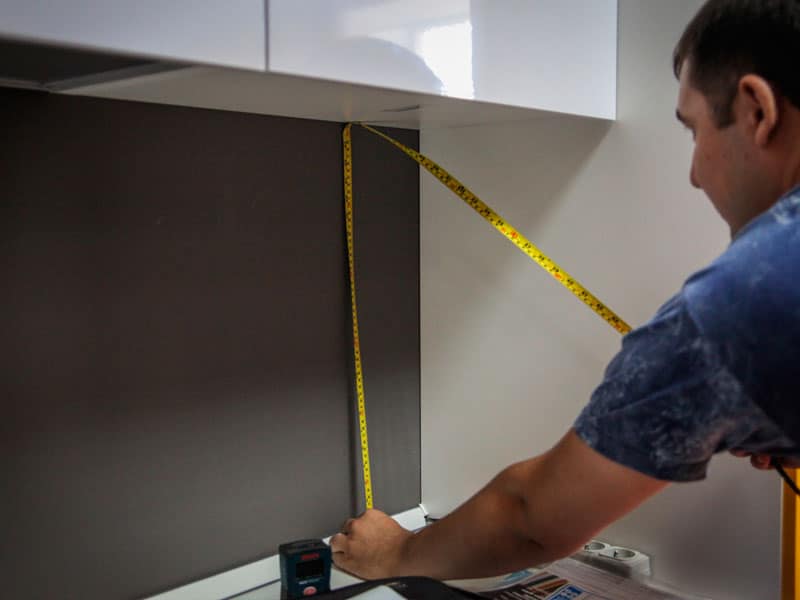
Measuring the height of the kitchen apron
It is also important to pre-mark the location of future holes in the apron for sockets or kitchen fixtures. suspension systems. Cutting holes with your own hands is not worth it, even if we are talking about plastic or MDF skins with photo printing, because you can ruin not only the plate, but also the image itself. Also, no processing. protective coating the edges of the MDF decorative panel will quickly become unusable, and the plastic may simply crack. Therefore, it is best to prepare a sketch in full size, adding an allowance of 5 mm to the intended slots, and provide it to the master who will make the panel.
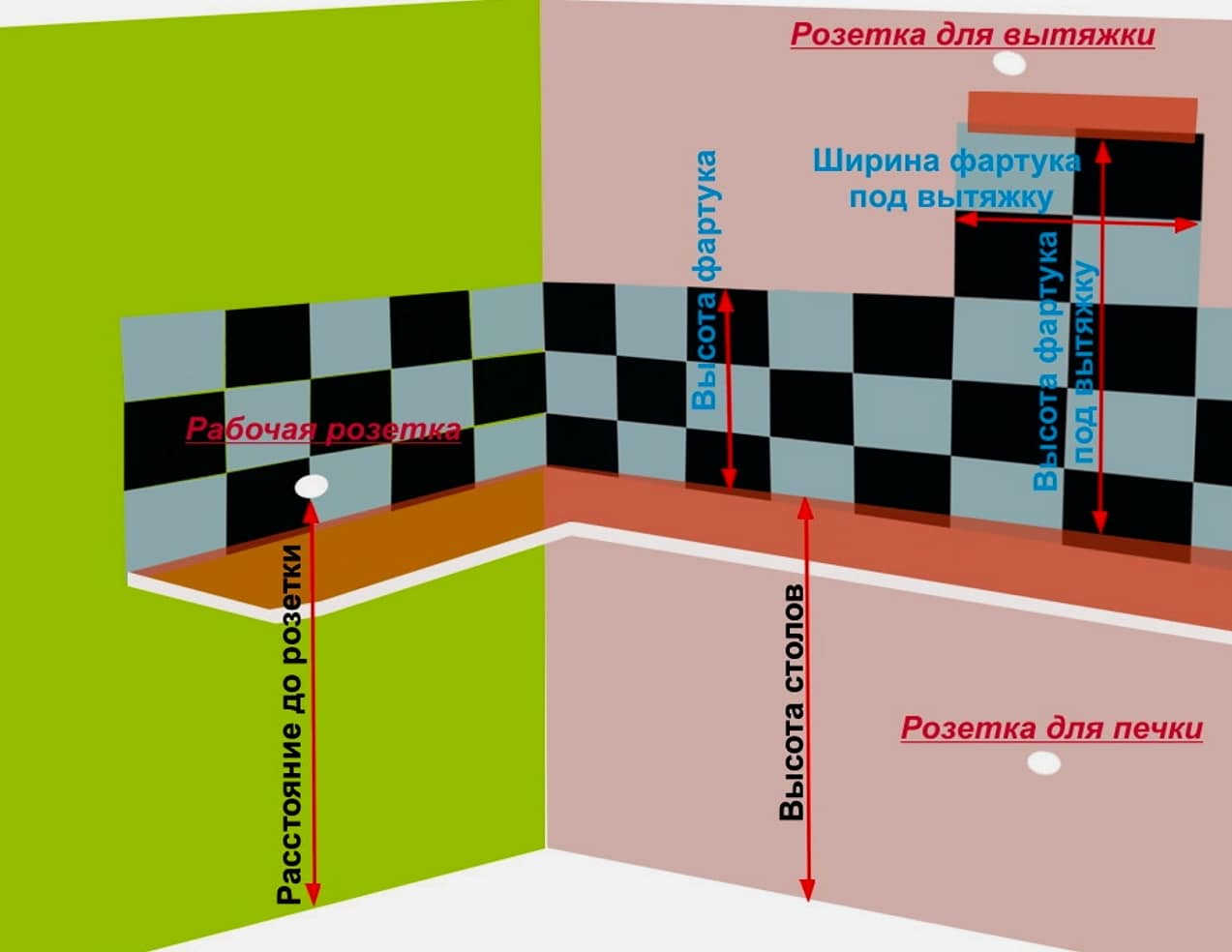
Important! Before the beginning installation work you need to examine the wall on which the apron will be installed. In case of significant damage to the surface (deep cracks, grooves, depressions), its integrity should be restored - putty the recesses or completely plaster the surface and apply antifungal impregnation.
Options for installing an apron for the kitchen
For wall sheet panels of reduced weight - MDF and plastic - the same installation methods are used. All of them are quite easy and available for independent execution.
- Gluing - suitable for walls with flat surface or minor fluctuations.
- A bar is attached to the dowel along the lower edge of the apron, aligned horizontally with a level.
- The wall is primed.
- Glue, such as liquid nails, is applied to the back of the panel. Glue is applied around the entire perimeter, as well as on the rest of the surface in strips with a distance of 20-30 cm.
- The lower edge of the sheet is installed on the mounting plate and the entire panel is pressed against the wall.
- After fixing the apron, remove the mounting plate.
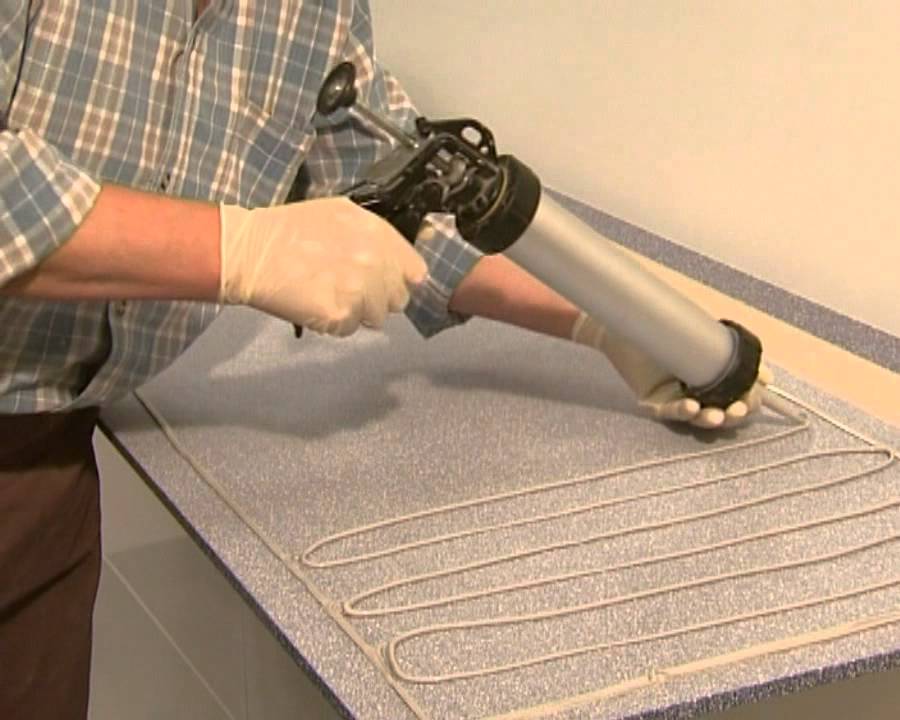
Applying adhesive to the back of the panel
- Fastening with self-tapping screws on a rack frame - for walls with noticeable plane differences.
- A crate is fixed to the wall with dowels. The upper and lower strips are located 10 cm from the edge of the panel, the middle ones are installed at a distance of 30-40 cm from each other. The entire frame is leveled with a level.
- If the frame is made from wooden beams, they are pre-treated with an antiseptic.
- A panel is fixed on the rails with self-tapping screws (only corners can be fixed for a plastic apron).
- Mounting holes on MDF boards are closed with special decorative plugs.
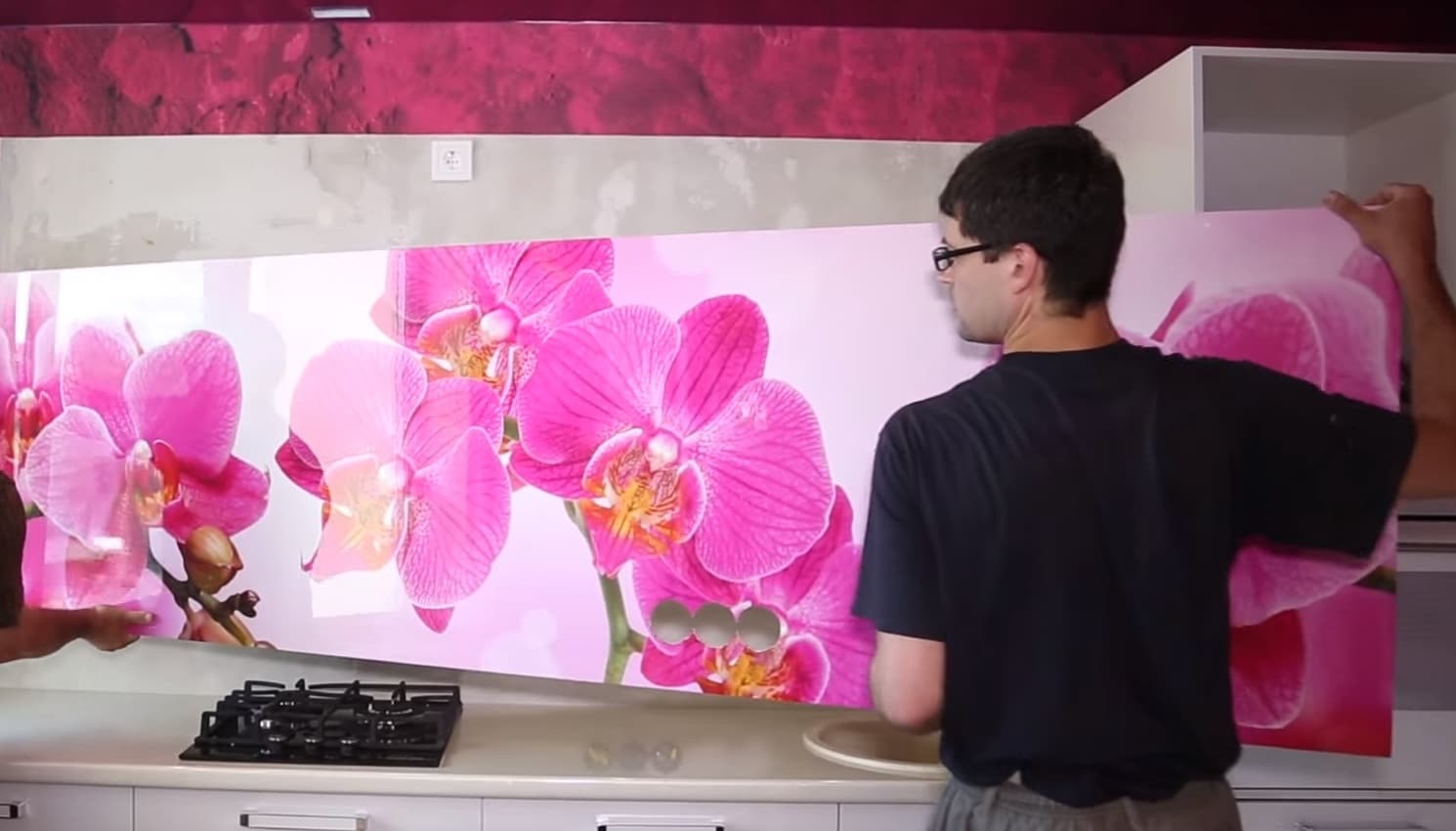
On final stage seal the gap between the wall panel and furniture (table and cabinet).
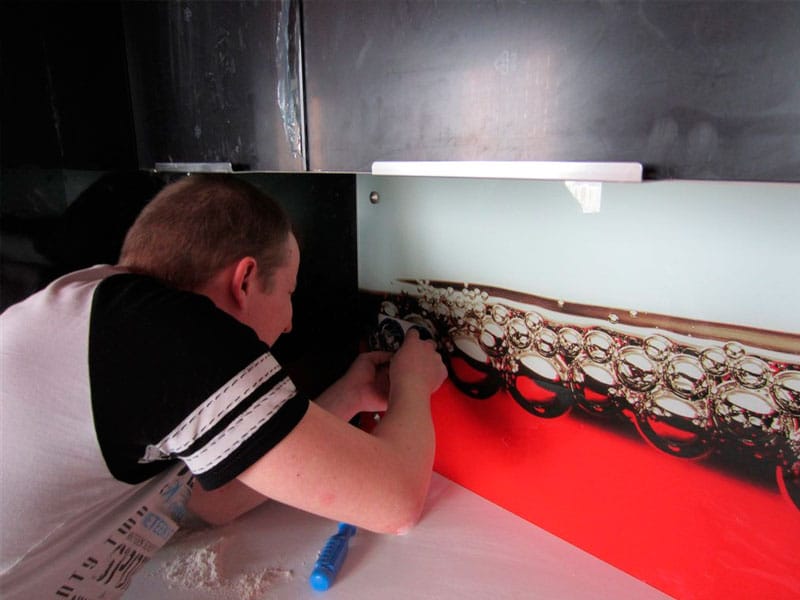
Sockets and switches are inserted into specially made holes for them.
- Installation on metal profiles Recommended for easy replacement of panels.
- On the upper and lower edges of the apron are installed aluminum profiles which are fixed on the wall with dowels or self-tapping screws.
- Apron panels are inserted between the "runners", which can be removed if necessary.
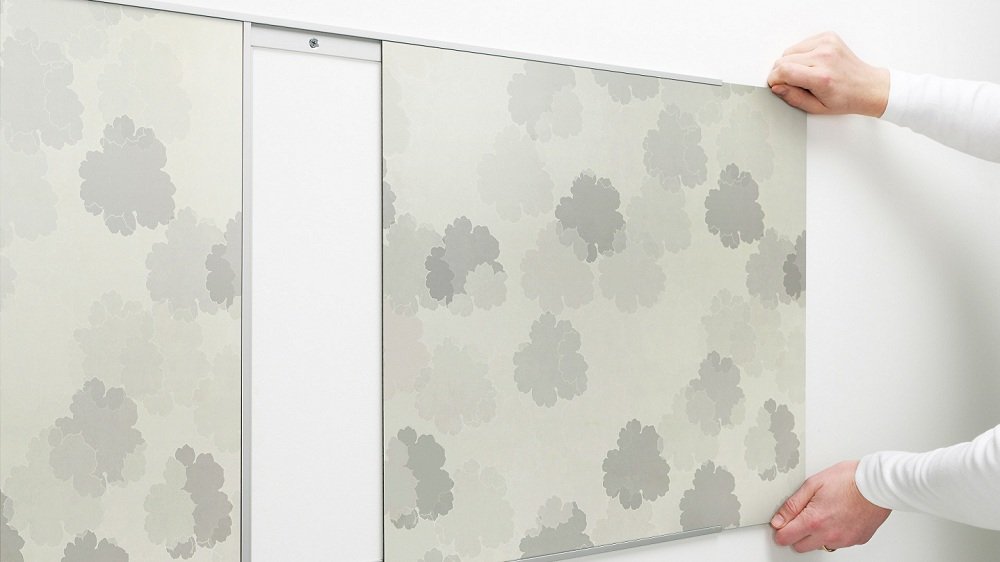
Advice! The method of fastening a kitchen apron with photo printing is selected depending on the condition of the wall and the type of panel material.
Video: will an apron made of MDF with photo printing withstand kitchen tests
Finishing the kitchen with an apron with photo printing is a great solution for a stylish and practical interior. Of course the most difficult stages repair is the right choice of the panel and its installation. Let's hope that our advice has helped you in prioritizing materials and finish design, and you can handle the installation yourself or entrust this process to professionals.

